- Question Papers
- Scholarships

Top 20 Research Design MCQ With Answers
Below given are top 20 important Research Design MCQ with answers. These updated multiple choice questions on research design are helpful for BBA, B Com, MBA, MMS, BMS, B Sc, Engineering, PGDM, M Phil and Ph D students and researchers. These MCQs will help for UGC NET, SET, MPSC, UPSC and other competitive entrance exams.
_______research is based on the measurement of quantity or amount.
A. Qualitative
B. Descriptive
C. Quantitative
D. Numerical
______ describes the present state of affairs as it exists without having any control over variables.
A. Analytical research
B. Descriptive research
C. Applied research
D. Distinctive research
In the _______research, the researcher has to use facts or information already available .
A. Analytical
D. Distinctive
__ ___ research is concerned with qualitative phenomena.
______ is related to some abstract ideas or theory.
A. Contextual research
B. Conceptual research
C. Ideal research
D. Empirical research
______ is data-based, coming up with conclusions that are capable of being verified, by observation or by experiment.
The objective of ______ is the development of hypotheses rather than their testing .
A. Laboratory research
B. Diagnostic research
C. Exploratory research
A ________ refers to some difficulty that a researcher experiences in either a theoretical or practical situation
A. research hypothesis
B. research experience
C. research problem
D. research crisis
_______ as a testable statement of a potential relationship between two or more variables.
Research design is a _________for conducting the marketing research project.
A. strategy
B. framework
C. blueprint
D. both B & C
______ is a hypothetical statements denying what are explicitly indicated in working hypotheses.
A. Null hypotheses
B. Working hypotheses
C. Descriptive hypotheses
D. Relational hypotheses
A Blue print of Research work is known as _______
A. sampling design
B. research design
C. research hypotheses
D. research approach
Research design is a blue print, outline and a _________
A. guidance
D. strategy
The choice of research design is influenced by the ________
A. the nature of the research problem
B. the audiences for the study
C. the researchers’ personal experiences
D. all of the above
A Blue print of Research work is called ____
A. Research design
B. Research Problem
C. Research methods
D. Research tools
_______ affect the choice of research methods .
A. Whether the research is ethical or not
B. Time and money available
C. Aims of the researcher
________ is the name of the conceptual framework in which the research is carried out.
A. Research paradigm
B. Synopsis of Research
C. Research design
D. Research hypothesis
The longitudinal research approach mainly deal with _____
A. Horizontal research
B. Vertical Research
C. Short-term research
D. Long-term research
Authenticity of a research finding is its ____
A. Objectivity
B. Tangibility
C. Originality
D. Validity
Research design is a blue print, outline and a ______
A. Strategy
This is all about solved MCQ on Research Design and related concepts.
You’ll also like Business Research Methods MCQ With Answers .
Share with friends
- Technical Support
- Find My Rep
You are here
100 Questions (and Answers) About Research Methods
- Neil J. Salkind
- Description
"How do I create a good research hypothesis?"
"How do I know when my literature review is finished?"
"What is the difference between a sample and a population?"
"What is power and why is it important?"
In an increasingly data-driven world, it is more important than ever for students as well as professionals to better understand the process of research. This invaluable guide answers the essential questions that students ask about research methods in a concise and accessible way.
| ISBN: 9781412992039 | Paperback | Suggested Retail Price: $42.00 | Bookstore Price: $33.60 |
| ISBN: 9781452235585 | Electronic Version | Suggested Retail Price: $36.00 | Bookstore Price: $28.80 |
See what’s new to this edition by selecting the Features tab on this page. Should you need additional information or have questions regarding the HEOA information provided for this title, including what is new to this edition, please email [email protected] . Please include your name, contact information, and the name of the title for which you would like more information. For information on the HEOA, please go to http://ed.gov/policy/highered/leg/hea08/index.html .
For assistance with your order: Please email us at [email protected] or connect with your SAGE representative.
SAGE 2455 Teller Road Thousand Oaks, CA 91320 www.sagepub.com
"This is a concise text that has good coverage of the basic concepts and elementary principles of research methods. It picks up where many traditional research methods texts stop and provides additional discussion on some of the hardest to understand concepts."
"I think it’s a great idea for a text (or series), and I have no doubt that the majority of students would find it helpful. The material is presented clearly, and it is easy to read and understand. My favorite example from those provided is on p. 7 where the author provides an actual checklist for evaluating the merit of a study. This is a great tool for students and would provide an excellent “practice” approach to learning this skill. Over time students wouldn’t need a checklist, but I think it would be invaluable for those students with little to no research experience."
I already am using 3 other books. This is a good book though.
Did not meet my needs
I had heard good things about Salkind's statistics book and wanted to review his research book as well. The 100 questions format is cute, and may provide a quick answer to a specific student question. However, it's not really organized in a way that I find particularly useful for a more integrated course that progressively develop and builds upon concepts.
comes across as a little disorganized, plus a little too focused on psychology and statistics.
This text is a great resource guide for graduate students. But it may not work as well with undergraduates orienting themselves to the research process. However, I will use it as a recommended text for students.
Key Features
· The entire research process is covered from start to finish: Divided into nine parts, the book guides readers from the initial asking of questions, through the analysis and interpretation of data, to the final report
· Each question and answer provides a stand-alone explanation: Readers gain enough information on a particular topic to move on to the next question, and topics can be read in any order
· Most questions and answers supplement others in the book: Important material is reinforced, and connections are made between the topics
· Each answer ends with referral to three other related questions: Readers are shown where to go for additional information on the most closely related topics
Sample Materials & Chapters
Question #16: Question #16: How Do I Know When My Literature Review Is Finished?
Question #32: How Can I Create a Good Research Hypothesis?
Question #40: What Is the Difference Between a Sample and a Population, and Why
Question #92: What Is Power, and Why Is It Important?
For instructors
Select a purchasing option.
Basics of Research Design MCQs
Research methods (statistics and applications) mcqs topics.
General MCQs
Thinking Like A Researcher MCQs
Build a Solid Foundation on Past Research MCQs
Cornerstones of Good Research MCQs
Describing Research Methods MCQs
Making Inferences Based on Your Research MCQs
Comparing Research with Expected Score MCQs
Examining Relationships among Statistics and Applications MCQs
Examining Causality of Research MCQs
Independent-Groups Design of Research MCQs
Dependent-Groups Designs of Research MCQs
Factorial Designs of Research MCQs
Nonparametric Statistics MCQs
Focusing on the Individual Research MCQs
These Basics of Research Design multiple-choice questions and their answers will help you strengthen your grip on the subject of Basics of Research Design. You can prepare for an upcoming exam or job interview with these 50 Basics of Research Design MCQs. So scroll down and start answering.
1: Analysis of existing data or records is called
A. Archival research
B. Scientific research
C. Filer research
D. All of above
2: Observers are not informed of the _______ in order to reduce observer bias is called blind observer.
A. Hypotheses
B. Experiments
C. Data
D. Analysis
3: Checklist is a list of qualities or behaviors that are checked if present.
A. True
B. False
4: A type of probability sampling in which groups, or clusters, are randomly selected instead of individuals is called
A. Cluster sampling
B. Non group sampling
C. Sampling
D. Random sampling
5: Someone who is working with the researcher but pretends to be a participant or bystander is called confederate
6: confidence interval is an estimation of the range of val-ues within which the scores will fall (margin of error)., 7: a measure of how likely the _____ will fall within a stated confidence interval is. called confidence level.
A. Data
B. Scores
C. Results
D. None of above
8: The researcher sets up the sit-uation and observes how participants or subjects respond is called
A. Unplanned research
B. Contrived research
C. Obverse research
9: A type of nonprobability sam-ple made up of those volunteers or others who are readily available and willing to participate is called
A. Convenience sampling
B. In convenience sampling.
C. Non sampling
10: Covert Observations are made without the participants’ awareness
11: how long a behavior lasts is known as.
A. Duration
B. Infinity
C. Long lasting
12: ______ is the interviewer may provide verbal or nonverbal cues that impact how the participant responds..
A. Interviewer bias
B. Interviewer non - bias
C. Interviewer impartial
13: The ______between stopping one task and begin-ning a new task is called latency
A. Speed
B. Distance
C. Time
D. Work
14: A _________ strategy in which the researcher seeks out the full range of extremes in the population is called maximum variation sampling
B. Nonprobability sam-pling
C. Probability sam-pling
15: A detailed account of behaviors or responses is called narrative
16: naturalistic observation is observation that occurs in a natural environment or situation and does not involve interference by anyone involved in the research., 17: the researcher or observer is not directly involved in the situation is called participant observation, 18: process of obtaining a study sample without using random selection is called.
B. Nonprobability sampling
19: The extent to which those who were selected and participated in the study differ from those who were selected but did not participate is known as
A. Non response bias
B. Response bias
C. Interviewerbias
20: In ______the observers pay closer attention to behaviors that support their expectations or interpret behaviors in ways that support their expectations or lose their focus on the target behavior.
C. Interviewer bias
D. Observer bias
21: No attempts are made to hide the observation is known as ______
A. Overt observation
B. Participant observation
C. Viewer observation
22: The researcher or observer becomes actively involved in the situation.
23: a preliminary study with a small sample to test measures and procedures is called pilot study, 24: the group that a researcher is interested in examining defined by specific characteristics such as resi-dency, occupation, gender, or age is called.
A. Population
B. Community
C. Species
25: Prevalence is a common or widespread behavior, attitude, characteristic, or condition is within a specific time period
26: ________ sampling is a process of obtaining a study sample using random selection..
A. Probability sampling
B. Non probability sampling
C. Quota sampling
27: A type of nonprobability sampling that results in the sample representing key subpopulations based on characteristics such as age, gender, and ethnicity.
28: random selectiob is a process of selecting a sample in which all members of a population or a subpopulation have an equal chance of being selected., 29: random selection with replacement is a selected member of the population is returned to the pool of pos-sible participants so that any member may be selected into the sample more than once., 30: random selection without replacement is a selected member of the population is removed from the pool of possible participants so that any member may be selected into the sample only once., 31: a numerical rating of a particular quality is called ..
A. Rating scale
B. Nominal scale
C. Pilot scale
D. Ordinal scale
32: Reaction time is a time taken by participant to respond to a stimulus.
33: a subset of the population from which _____ are collected is called sample.
B. Results
C. Participants
34: The process by which a sample is selected is known as _____
A. Sampling
B. Sampling bias
C. Simple random sampling
D. Snowball sampling
35: When some members of a population are overrepresented in the sample is known as
36: research data that were collected by one researcher or group but analyzed by a different researcher or group..
A. Secondary data
B. Primary data
C. Primary and secondary data
37: There is a set of core questions or topics that the interviewer will follow, but the interviewer may prompt for more information, ask fol-low-up questions, or clarify questions as the interviewer deems necessary is called Semi-structures interviews
38: ______ is a type of probability sampling in which every single member of the population has an equal chance of being selected for the sample., 39: participants may respond based on how they want to be perceived or what is socially acceptable is called non social desirability bias, 40: a type of probability sampling that results in the sample representing key sub-populations based on characteristics such as age, gender, and ethnicity.is called.
A. Stratified random sampling
41: All questions, follow-up ques-tions, and responses by the interviewer are determined beforehand to ensure that all the participants have a very similar experience is called structured reviews
42: sub population is a portion or subgroup of the population., 43: interviews or questionnaires in which participants report on their attitudes and behaviors is called survey research, 44: the time it takes to complete a task is known as.
A. Task completion time
B. Task completion speed
C. Task completion distance
45: Pattern of change in prevalence over _____ is called trend
A. Time
C. Speed
D. Power
46: If you measure how long a person takes to wash his or her hands in a public restroom, you are measuring ______.
B. Task completion time
C. Reaction time
D. Latency
47: If you rely on participants to recruit other participants for you, you are likely using ______.
A. Snowball sampling
B. Cluster sampling
C. Random assignment
D. Quota sampling
48: When a researcher seeks out the full range of extremes in the population for representation in her sample, this is known as ______.
A. Extreme sampling
C. Maximum variation sampling
D. Wide-range sampling
49: A type of probability sampling in which every single member of the population has an equal chance of being selected for the sample is known as ______.
D. Simple random sampling
50: Which of the following is a potential flaw of interviews?
B. Amount of time required
C. Lack of anonymity
D. All of these
List of Basics of Research Des...
Related basics of research design mcqs:, available in:, latest mcqs:.
Politics of the United States MCQs
Geographic Regions MCQs
Physical Geography MCQs
Atmospheric Energy MCQs
Human Geography MCQs
Popular MCQs:
Privacy Policy | Terms and Conditions | Contact Us
© copyright 2024 by mcqss.com
Have a language expert improve your writing
Run a free plagiarism check in 10 minutes, generate accurate citations for free.
- Knowledge Base
Methodology
- What Is a Research Design | Types, Guide & Examples
What Is a Research Design | Types, Guide & Examples
Published on June 7, 2021 by Shona McCombes . Revised on November 20, 2023 by Pritha Bhandari.
A research design is a strategy for answering your research question using empirical data. Creating a research design means making decisions about:
- Your overall research objectives and approach
- Whether you’ll rely on primary research or secondary research
- Your sampling methods or criteria for selecting subjects
- Your data collection methods
- The procedures you’ll follow to collect data
- Your data analysis methods
A well-planned research design helps ensure that your methods match your research objectives and that you use the right kind of analysis for your data.
Table of contents
Step 1: consider your aims and approach, step 2: choose a type of research design, step 3: identify your population and sampling method, step 4: choose your data collection methods, step 5: plan your data collection procedures, step 6: decide on your data analysis strategies, other interesting articles, frequently asked questions about research design.
- Introduction
Before you can start designing your research, you should already have a clear idea of the research question you want to investigate.
There are many different ways you could go about answering this question. Your research design choices should be driven by your aims and priorities—start by thinking carefully about what you want to achieve.
The first choice you need to make is whether you’ll take a qualitative or quantitative approach.
| Qualitative approach | Quantitative approach |
|---|---|
| and describe frequencies, averages, and correlations about relationships between variables |
Qualitative research designs tend to be more flexible and inductive , allowing you to adjust your approach based on what you find throughout the research process.
Quantitative research designs tend to be more fixed and deductive , with variables and hypotheses clearly defined in advance of data collection.
It’s also possible to use a mixed-methods design that integrates aspects of both approaches. By combining qualitative and quantitative insights, you can gain a more complete picture of the problem you’re studying and strengthen the credibility of your conclusions.
Practical and ethical considerations when designing research
As well as scientific considerations, you need to think practically when designing your research. If your research involves people or animals, you also need to consider research ethics .
- How much time do you have to collect data and write up the research?
- Will you be able to gain access to the data you need (e.g., by travelling to a specific location or contacting specific people)?
- Do you have the necessary research skills (e.g., statistical analysis or interview techniques)?
- Will you need ethical approval ?
At each stage of the research design process, make sure that your choices are practically feasible.
Here's why students love Scribbr's proofreading services
Discover proofreading & editing
Within both qualitative and quantitative approaches, there are several types of research design to choose from. Each type provides a framework for the overall shape of your research.
Types of quantitative research designs
Quantitative designs can be split into four main types.
- Experimental and quasi-experimental designs allow you to test cause-and-effect relationships
- Descriptive and correlational designs allow you to measure variables and describe relationships between them.
| Type of design | Purpose and characteristics |
|---|---|
| Experimental | relationships effect on a |
| Quasi-experimental | ) |
| Correlational | |
| Descriptive |
With descriptive and correlational designs, you can get a clear picture of characteristics, trends and relationships as they exist in the real world. However, you can’t draw conclusions about cause and effect (because correlation doesn’t imply causation ).
Experiments are the strongest way to test cause-and-effect relationships without the risk of other variables influencing the results. However, their controlled conditions may not always reflect how things work in the real world. They’re often also more difficult and expensive to implement.
Types of qualitative research designs
Qualitative designs are less strictly defined. This approach is about gaining a rich, detailed understanding of a specific context or phenomenon, and you can often be more creative and flexible in designing your research.
The table below shows some common types of qualitative design. They often have similar approaches in terms of data collection, but focus on different aspects when analyzing the data.
| Type of design | Purpose and characteristics |
|---|---|
| Grounded theory | |
| Phenomenology |
Your research design should clearly define who or what your research will focus on, and how you’ll go about choosing your participants or subjects.
In research, a population is the entire group that you want to draw conclusions about, while a sample is the smaller group of individuals you’ll actually collect data from.
Defining the population
A population can be made up of anything you want to study—plants, animals, organizations, texts, countries, etc. In the social sciences, it most often refers to a group of people.
For example, will you focus on people from a specific demographic, region or background? Are you interested in people with a certain job or medical condition, or users of a particular product?
The more precisely you define your population, the easier it will be to gather a representative sample.
- Sampling methods
Even with a narrowly defined population, it’s rarely possible to collect data from every individual. Instead, you’ll collect data from a sample.
To select a sample, there are two main approaches: probability sampling and non-probability sampling . The sampling method you use affects how confidently you can generalize your results to the population as a whole.
| Probability sampling | Non-probability sampling |
|---|---|
Probability sampling is the most statistically valid option, but it’s often difficult to achieve unless you’re dealing with a very small and accessible population.
For practical reasons, many studies use non-probability sampling, but it’s important to be aware of the limitations and carefully consider potential biases. You should always make an effort to gather a sample that’s as representative as possible of the population.
Case selection in qualitative research
In some types of qualitative designs, sampling may not be relevant.
For example, in an ethnography or a case study , your aim is to deeply understand a specific context, not to generalize to a population. Instead of sampling, you may simply aim to collect as much data as possible about the context you are studying.
In these types of design, you still have to carefully consider your choice of case or community. You should have a clear rationale for why this particular case is suitable for answering your research question .
For example, you might choose a case study that reveals an unusual or neglected aspect of your research problem, or you might choose several very similar or very different cases in order to compare them.
Data collection methods are ways of directly measuring variables and gathering information. They allow you to gain first-hand knowledge and original insights into your research problem.
You can choose just one data collection method, or use several methods in the same study.
Survey methods
Surveys allow you to collect data about opinions, behaviors, experiences, and characteristics by asking people directly. There are two main survey methods to choose from: questionnaires and interviews .
| Questionnaires | Interviews |
|---|---|
| ) |
Observation methods
Observational studies allow you to collect data unobtrusively, observing characteristics, behaviors or social interactions without relying on self-reporting.
Observations may be conducted in real time, taking notes as you observe, or you might make audiovisual recordings for later analysis. They can be qualitative or quantitative.
| Quantitative observation | |
|---|---|
Other methods of data collection
There are many other ways you might collect data depending on your field and topic.
| Field | Examples of data collection methods |
|---|---|
| Media & communication | Collecting a sample of texts (e.g., speeches, articles, or social media posts) for data on cultural norms and narratives |
| Psychology | Using technologies like neuroimaging, eye-tracking, or computer-based tasks to collect data on things like attention, emotional response, or reaction time |
| Education | Using tests or assignments to collect data on knowledge and skills |
| Physical sciences | Using scientific instruments to collect data on things like weight, blood pressure, or chemical composition |
If you’re not sure which methods will work best for your research design, try reading some papers in your field to see what kinds of data collection methods they used.
Secondary data
If you don’t have the time or resources to collect data from the population you’re interested in, you can also choose to use secondary data that other researchers already collected—for example, datasets from government surveys or previous studies on your topic.
With this raw data, you can do your own analysis to answer new research questions that weren’t addressed by the original study.
Using secondary data can expand the scope of your research, as you may be able to access much larger and more varied samples than you could collect yourself.
However, it also means you don’t have any control over which variables to measure or how to measure them, so the conclusions you can draw may be limited.
Prevent plagiarism. Run a free check.
As well as deciding on your methods, you need to plan exactly how you’ll use these methods to collect data that’s consistent, accurate, and unbiased.
Planning systematic procedures is especially important in quantitative research, where you need to precisely define your variables and ensure your measurements are high in reliability and validity.
Operationalization
Some variables, like height or age, are easily measured. But often you’ll be dealing with more abstract concepts, like satisfaction, anxiety, or competence. Operationalization means turning these fuzzy ideas into measurable indicators.
If you’re using observations , which events or actions will you count?
If you’re using surveys , which questions will you ask and what range of responses will be offered?
You may also choose to use or adapt existing materials designed to measure the concept you’re interested in—for example, questionnaires or inventories whose reliability and validity has already been established.
Reliability and validity
Reliability means your results can be consistently reproduced, while validity means that you’re actually measuring the concept you’re interested in.
| Reliability | Validity |
|---|---|
| ) ) |
For valid and reliable results, your measurement materials should be thoroughly researched and carefully designed. Plan your procedures to make sure you carry out the same steps in the same way for each participant.
If you’re developing a new questionnaire or other instrument to measure a specific concept, running a pilot study allows you to check its validity and reliability in advance.
Sampling procedures
As well as choosing an appropriate sampling method , you need a concrete plan for how you’ll actually contact and recruit your selected sample.
That means making decisions about things like:
- How many participants do you need for an adequate sample size?
- What inclusion and exclusion criteria will you use to identify eligible participants?
- How will you contact your sample—by mail, online, by phone, or in person?
If you’re using a probability sampling method , it’s important that everyone who is randomly selected actually participates in the study. How will you ensure a high response rate?
If you’re using a non-probability method , how will you avoid research bias and ensure a representative sample?
Data management
It’s also important to create a data management plan for organizing and storing your data.
Will you need to transcribe interviews or perform data entry for observations? You should anonymize and safeguard any sensitive data, and make sure it’s backed up regularly.
Keeping your data well-organized will save time when it comes to analyzing it. It can also help other researchers validate and add to your findings (high replicability ).
On its own, raw data can’t answer your research question. The last step of designing your research is planning how you’ll analyze the data.
Quantitative data analysis
In quantitative research, you’ll most likely use some form of statistical analysis . With statistics, you can summarize your sample data, make estimates, and test hypotheses.
Using descriptive statistics , you can summarize your sample data in terms of:
- The distribution of the data (e.g., the frequency of each score on a test)
- The central tendency of the data (e.g., the mean to describe the average score)
- The variability of the data (e.g., the standard deviation to describe how spread out the scores are)
The specific calculations you can do depend on the level of measurement of your variables.
Using inferential statistics , you can:
- Make estimates about the population based on your sample data.
- Test hypotheses about a relationship between variables.
Regression and correlation tests look for associations between two or more variables, while comparison tests (such as t tests and ANOVAs ) look for differences in the outcomes of different groups.
Your choice of statistical test depends on various aspects of your research design, including the types of variables you’re dealing with and the distribution of your data.
Qualitative data analysis
In qualitative research, your data will usually be very dense with information and ideas. Instead of summing it up in numbers, you’ll need to comb through the data in detail, interpret its meanings, identify patterns, and extract the parts that are most relevant to your research question.
Two of the most common approaches to doing this are thematic analysis and discourse analysis .
| Approach | Characteristics |
|---|---|
| Thematic analysis | |
| Discourse analysis |
There are many other ways of analyzing qualitative data depending on the aims of your research. To get a sense of potential approaches, try reading some qualitative research papers in your field.
If you want to know more about the research process , methodology , research bias , or statistics , make sure to check out some of our other articles with explanations and examples.
- Simple random sampling
- Stratified sampling
- Cluster sampling
- Likert scales
- Reproducibility
Statistics
- Null hypothesis
- Statistical power
- Probability distribution
- Effect size
- Poisson distribution
Research bias
- Optimism bias
- Cognitive bias
- Implicit bias
- Hawthorne effect
- Anchoring bias
- Explicit bias
A research design is a strategy for answering your research question . It defines your overall approach and determines how you will collect and analyze data.
A well-planned research design helps ensure that your methods match your research aims, that you collect high-quality data, and that you use the right kind of analysis to answer your questions, utilizing credible sources . This allows you to draw valid , trustworthy conclusions.
Quantitative research designs can be divided into two main categories:
- Correlational and descriptive designs are used to investigate characteristics, averages, trends, and associations between variables.
- Experimental and quasi-experimental designs are used to test causal relationships .
Qualitative research designs tend to be more flexible. Common types of qualitative design include case study , ethnography , and grounded theory designs.
The priorities of a research design can vary depending on the field, but you usually have to specify:
- Your research questions and/or hypotheses
- Your overall approach (e.g., qualitative or quantitative )
- The type of design you’re using (e.g., a survey , experiment , or case study )
- Your data collection methods (e.g., questionnaires , observations)
- Your data collection procedures (e.g., operationalization , timing and data management)
- Your data analysis methods (e.g., statistical tests or thematic analysis )
A sample is a subset of individuals from a larger population . Sampling means selecting the group that you will actually collect data from in your research. For example, if you are researching the opinions of students in your university, you could survey a sample of 100 students.
In statistics, sampling allows you to test a hypothesis about the characteristics of a population.
Operationalization means turning abstract conceptual ideas into measurable observations.
For example, the concept of social anxiety isn’t directly observable, but it can be operationally defined in terms of self-rating scores, behavioral avoidance of crowded places, or physical anxiety symptoms in social situations.
Before collecting data , it’s important to consider how you will operationalize the variables that you want to measure.
A research project is an academic, scientific, or professional undertaking to answer a research question . Research projects can take many forms, such as qualitative or quantitative , descriptive , longitudinal , experimental , or correlational . What kind of research approach you choose will depend on your topic.
Cite this Scribbr article
If you want to cite this source, you can copy and paste the citation or click the “Cite this Scribbr article” button to automatically add the citation to our free Citation Generator.
McCombes, S. (2023, November 20). What Is a Research Design | Types, Guide & Examples. Scribbr. Retrieved June 9, 2024, from https://www.scribbr.com/methodology/research-design/
Is this article helpful?
Shona McCombes
Other students also liked, guide to experimental design | overview, steps, & examples, how to write a research proposal | examples & templates, ethical considerations in research | types & examples, what is your plagiarism score.

MCQ on Experimental Design
Enhance your knowledge of Design of Experiments with our interactive quiz. Put your skills to the test with our engaging MCQs and excel in the science of efficient experimentation. This MCQ on Experimental Design will help you to understand the basic principles and applications of designs of experiments in biological research.
You may also like: Experimental Designs Notes | Types of Experimental Designs – Notes

You may also like: Biostatistics Notes | Biostatistics PPT | Biostatistics MCQs |
<<< Back to Statistics MCQ Page
Related posts:
- MCQ on Applications of Statistics in Research
- MCQ on t Test
- MCQ on z Test and its Applications
- MCQ on ANOVA (Analysis of Variance)
- MCQ on Coefficient of Variation
Please send question in statistics department related to exit exam
Leave a Reply Cancel reply
Your email address will not be published. Required fields are marked *
Privacy Overview
| Cookie | Duration | Description |
|---|---|---|
| cookielawinfo-checkbox-analytics | 11 months | This cookie is set by GDPR Cookie Consent plugin. The cookie is used to store the user consent for the cookies in the category "Analytics". |
| cookielawinfo-checkbox-functional | 11 months | The cookie is set by GDPR cookie consent to record the user consent for the cookies in the category "Functional". |
| cookielawinfo-checkbox-necessary | 11 months | This cookie is set by GDPR Cookie Consent plugin. The cookies is used to store the user consent for the cookies in the category "Necessary". |
| cookielawinfo-checkbox-others | 11 months | This cookie is set by GDPR Cookie Consent plugin. The cookie is used to store the user consent for the cookies in the category "Other. |
| cookielawinfo-checkbox-performance | 11 months | This cookie is set by GDPR Cookie Consent plugin. The cookie is used to store the user consent for the cookies in the category "Performance". |
| viewed_cookie_policy | 11 months | The cookie is set by the GDPR Cookie Consent plugin and is used to store whether or not user has consented to the use of cookies. It does not store any personal data. |
Research Methods- multiple choice exam questions

Students also viewed

By Gkseries see more questions
Research design mcqs | research design multiple choice questions with answers.
- General Knowledge /
- research design multiple choice questions with answers
Free download in PDF Research Design Multiple Choice Questions with Answers for competitive exams. These Research Design Objective Questions with Answers are important for competitive exams MBA, UGC NET, GATE, IBPS Specialist Recruitment Test..
View Answer
Answer: All of the above
Answer: A decision to accept or reject the hypothesis
| Article and Schedule Quiz |
DOWNLOAD CURRENT AFFAIRS PDF FROM APP
- 10 Important Books for UPSC Preparation
- 10 Important Books For SSC CGL, CPO, CHSL, and GD CONSTABLE Exam Preparation
Answer: It may not provide access to deviant or hidden activities
Answer: True life stories
Answer: One that encourages the interviewee to say more about a topic
Answer: Extant and research-driven
Answer: No, never under any circumstances
Answer: It is difficult to take notes without arousing suspicion
Answer: Introduction; Literature review; Research methods; Results; Discussion; Conclusion
Answer: Research questions
Answer: Sampling people, newspapers, television programmes etc
Answer: It is not feasible to construct a sampling frame of interactions
Answer: The measures devised for concepts are stable on different occasions
Answer: an ambiguous concept whose meaning depends on how it is defined
Answer: Comparative design
Answer: provide academic support, guidance and critical feedback on your work
ADRE 2.0 Free Mock Tests
Adre 2.0 full length mock test, take mock tests.
| Missiles Mock Test | |
| SSC MTS Mock Test | |
| IBPS CLERK MOCK TEST | |
| SSC MTS 2022 JULY 26 Shift 1 (ENGLISH) | |
| SSC GD Previous Year Paper 2021 Nov 17 Shift - I (Hindi) | |
| SSC CGL Tier - 1 PYP 2022 April 21 Shift- 1 (ENGLISH) | |
| MPSC PAPER I MOCK TEST 1 (ENGLISH) | |
| IB Security Assistant Mock test 1 (english) | |
| UP POLICE CONSTABLE MOCK TEST 1 | |
| DELHI POLICE CONSTABLE MOCK TEST 1 (HINDI) |

Latest Test Series

DELHI POLICE SI


WEST BENGAL PSC

CISF CONSTABLE

RRB RRC GROUP D

UP POLICE SI
Random gk questions, advertisement.
Research Methodology Quiz | MCQ (Multiple Choice Questions)
In order to enhance your understanding of research methodology, we have made thought-provoking quiz featuring multiple-choice questions.
The quiz aimed to sharpen your critical thinking skills and reinforce our grasp on essential concepts in the realm of research. By actively participating in this exercise, we deepened your appreciation for the significance of selecting the right research methods to achieve reliable and meaningful results.
Other articles
Related posts, what is an independent variable, how to write a conclusion for research paper | examples, six useful tips for finding research gap, example of abstract for your research paper: tips, dos, and don’ts, survey sampling: what it is, types & tips, cluster sampling | method and examples, advantages and disadvantages of snowball sampling, exploring qualitative researcher skills: what they are and how to develop them, difference between quota sampling and stratified sampling, what is purposive sampling | examples, leave a reply cancel reply.
Have an account?

Research Design
English, social studies.
10 questions

Introducing new Paper mode
No student devices needed. Know more
A research design is a blueprint for the collection, measurement, and analysis of data, based on _____ of the study
the purpose
the research questions
the introduction
An exploratory study is undertaken when not much is known about _____ at hand, or no information is available on how similar problems have been solved in the past.
the situation
the characteristics
Examples of exploratory research design EXCEPT:
A study into the role of social networking sites as an effective marketing communication channel
An investigation into the ways of improvement of quality of customer services within hospitality sector in London
Market researchers that want to observe habits of consumers.
Exploratory research often relies on _____ research such as review of the literature and/or _____ approaches to data gathering.
primary, quantitative
secondary, quantitative
primary, qualitative
secondary, qualitative
Descriptive research's objective is to _____.
Descriptive studies may help the research to EXCEPT:
Understand the characteristics of a group in a given situation.
Think systematically about aspects in a given situation.
Explore new areas of research.
TWO examples of descriptive research:
A specialty food group launching a new range of barbecue rubs would like to understand what flavors of rubs are favored by different sets of people.
An assessment of the role of corporate social responsibility on consumer behavior in pharmaceutical industry in the USA.
A company that wants to evaluate the morale of its staff.
TWO advantages of descriptive research design:
Effective in laying the groundwork that will lead to future studies.
The opportunity to integrate the qualitative and quantitative methods of data collection
Helping the researcher to understand the characteristics of a group
Causal research tests whether or not one variable causes another to change.
Examples of research objectives for causal research design EXCEPT:
To assess the impacts of foreign direct investment on the levels of economic growth in Taiwan.
To analyse the effects of re-branding initiatives on the levels of customer loyalty.
To investigate the work ethic values of employees working in branch A are different from those in branch B.
Explore all questions with a free account

Continue with email
Continue with phone

- Definitions
Verbal Ability
- Interview Q
| 1) Who was the author of the book named "Methods in Social Research"? c) Goode and HaltThe book named "Methods in Social Research" was authored by Goode and Hatt on Dec 01, 1952, which was specifically aimed to improve student's knowledge as well as response skills. a) Association among variablesMainly the correlational analysis focus on finding the association between one or more quantitative independent variables and one or more quantitative dependent variables. d) Research designA conceptual framework can be understood as a Research design that you require before research. d) To help an applicant in becoming a renowned educationalistEducational research can be defined as an assurance for reviewing and improving educational practice, which will result in becoming a renowned educationalist. c) Collecting data with bottom-up empirical evidence.In qualitative research, we use an inductive methodology that starts from particular to general. In other words, we study society from the bottom, then move upward to make the theories. d) All of the aboveIn random sampling, for each element of the set, there exist a possibility to get selected. c) Ex-post facto methodMainly in the ex-post facto method, the existing groups with qualities are compared on some dependent variable. It is also known as quasi-experimental for the fact that instead of randomly assigning the subjects, they are grouped on the basis of a particular characteristic or trait. d) All of the aboveTippit table was first published by L.H.C Tippett in 1927. b) Formulating a research questionBefore starting with research, it is necessary to have a research question or a topic because once the problem is identified, then we can decide the research design. c) A research dissertationThe format of thesis writing is similar to that of a research dissertation, or we can simply say that dissertation is another word for a thesis. d) Its sole purpose is the production of knowledgeParticipatory action research is a kind of research that stresses participation and action. b) It is only the null hypothesis that can be tested.Hypotheses testing evaluates its plausibility by using sample data. b) The null hypotheses get rejected even if it is trueThe Type-I Error can be defined as the first kind of error. d) All of the above.No explanation. a) Long-term researchIn general, the longitudinal approach is long-term research in which the researchers keep on examining similar individuals to detect if any change has occurred over a while. b) Following an aimNo explanation. a) How well are we doing?Instead of focusing on the process, the evaluation research measures the consequences of the process, for example, if the objectives are met or not. d) Research is not a processResearch is an inspired and systematic work that is undertaken by the researchers to intensify expertise. d) All of the aboveResearch is an inspired and systematic work that is undertaken by the researchers to intensify expertise. b) To bring out the holistic approach to researchParticularly in interdisciplinary research, it combines two or more hypothetical disciplines into one activity. d) Eliminate spurious relationsScientific research aims to build knowledge by hypothesizing new theories and discovering laws. c) QuestionnaireSince it is an urban area, so there is a probability of literacy amongst a greater number of people. Also, there would be numerous questions over the ruling period of a political party, which cannot be simply answered by rating. The rating can only be considered if any political party has done some work, which is why the Questionnaire is used. b) Historical ResearchOne cannot generalize historical research in the USA, which has been done in India. c) By research objectivesResearch objectives concisely demonstrate what we are trying to achieve through the research. c) Has studied research methodologyAnyone who has studied the research methodology can undergo the research. c) ObservationMainly the research method comprises strategies, processes or techniques that are being utilized to collect the data or evidence so as to reveal new information or create a better understanding of a topic. d) All of the aboveA research problem can be defined as a statement about the area of interest, a condition that is required to be improved, a difficulty that has to be eradicated, or any disquieting question existing in scholarly literature, in theory, or in practice that points to be solved. d) How are various parts related to the whole?A circle graph helps in visualizing information as well as the data. b) ObjectivityNo explanation. a) Quota samplingIn non-probability sampling, all the members do not get an equal opportunity to participate in the study. a) Reducing punctuations as well as grammatical errors to minimalist Select the answers from the codes given below: B. a), b), c) and d)All of the above. a) Research refers to a series of systematic activity or activities undertaken to find out the solution to a problem. Select the correct answer from the codes given below: A. a), b), c) and d)All of the above. b) Fundamental ResearchJean Piaget, in his cognitive-developmental theory, proposed the idea that children can actively construct knowledge simply by exploring and manipulating the world around them. d) Introduction; Literature Review; Research Methodology; Results; Discussions and ConclusionsThe core elements of the dissertation are as follows: Introduction; Literature Review; Research Methodology; Results; Discussions and Conclusions d) A sampling of people, newspapers, television programs etc.In general, sampling in case study research involves decisions made by the researchers regarding the strategies of sampling, the number of case studies, and the definition of the unit of analysis. a) Systematic Sampling TechniqueSystematic sampling can be understood as a probability sampling method in which the members of the population are selected by the researchers at a regular interval. a) Social relevanceNo explanation. c) Can be one-tailed as well as two-tailed depending on the hypothesesAn F-test corresponds to a statistical test in which the test statistic has an F-distribution under the null hypothesis. a) CensusCensus is an official survey that keeps track of the population data. b) ObservationNo explanation. d) It contains dependent and independent variablesA research problem can be defined as a statement about the concerned area, a condition needed to be improved, a difficulty that has to be eliminated, or a troubling question existing in scholarly literature, in theory, or in practice pointing towards the need of delivering a deliberate investigation. d) All of the aboveThe research objectives must be concisely described before starting the research as it illustrates what we are going to achieve as an end result after the accomplishment. c) A kind of research being carried out to solve a specific problemIn general, action research is termed as a philosophy or a research methodology, which is implemented in social sciences. a) The cultural background of the countryAn assumption can be identified as an unexamined belief, which we contemplate without even comprehending it. Also, the conclusions that we draw are often based on assumptions. d) All of the aboveNo explanation. b) To understand the difference between two variablesFactor analysis can be understood as a statistical method that defines the variability between two variables in terms of factors, which are nothing but unobserved variables. a) ManipulationIn an experimental research design, whenever the independent variables (i.e., treatment variables or factors) decisively get altered by researchers, then that process is termed as an experimental manipulation. d) Professional AttitudeA professional attitude is an ability that inclines you to manage your time, portray a leadership quality, make you self-determined and persistent. b) Human RelationsThe term sociogram can be defined as a graphical representation of human relation that portrays the social links formed by one particular person. c) Objective ObservationThe research process comprises classifying, locating, evaluating, and investigating the data, which is required to support your research question, followed by developing and expressing your ideas. |

- Send your Feedback to [email protected]
Help Others, Please Share

Learn Latest Tutorials
Transact-SQL
Reinforcement Learning
R Programming
React Native
Python Design Patterns
Python Pillow
Python Turtle
Preparation

Interview Questions

Company Questions
Trending Technologies
Artificial Intelligence
Cloud Computing
Data Science
Machine Learning
B.Tech / MCA
Data Structures
Operating System
Computer Network
Compiler Design
Computer Organization
Discrete Mathematics
Ethical Hacking
Computer Graphics
Software Engineering
Web Technology
Cyber Security
C Programming
Control System
Data Mining
Data Warehouse

Course & Exam Pages
The independent source for health policy research, polling, and news.
Disparities in Health and Health Care: 5 Key Questions and Answers
Nambi Ndugga and Samantha Artiga Published: Apr 21, 2023
Introduction
The COVID-19 pandemic and nationwide racial justice movement over the past several years have heightened the focus on health disparities and their underlying causes and contributed to the increased prioritization of health equity. These disparities are not new and reflect longstanding structural and systemic inequities rooted in racism and discrimination. Although growing efforts have focused recently on addressing disparities, the ending of some policies implemented during the COVID-19 pandemic, including continuous enrollment for Medicaid and the Children’s Health Insurance Program (CHIP), may reverse progress and widen disparities. Addressing health disparities is not only important from an equity standpoint, but also for improving the nation’s overall health and economic prosperity. This brief provides an introduction to what health and health care disparities are, why it is important to address disparities, what the status of disparities is today, recent federal actions to address disparities, and key issues related to addressing disparities looking ahead.
What are health and health care disparities?
Health and health care disparities refer to differences in health and health care between groups that stem from broader inequities . There are multiple definitions of health disparities. Healthy People 2030 defines a health disparity, as “a particular type of health difference that is linked with social, economic, and/or environmental disadvantage,” and that adversely affects groups of people who have systematically experienced greater obstacles to health. The Centers for Disease Control and Prevention (CDC) defines health disparities as, “preventable differences in the burden, disease, injury, violence, or in opportunities to achieve optimal health experienced by socially disadvantaged racial, ethnic, and other population groups and communities.” A health care disparity typically refers to differences between groups in health insurance coverage, affordability, access to and use of care, and quality of care. The terms “health inequality” and “inequity” are also sometimes used to describe unjust differences. Racism, which the CDC defines as the structures, policies, practices, and norms that assign value and determine opportunities based on the way people look or the color of their skin, results in conditions that unfairly advantage some and disadvantage others, placing people of color at greater risk for poor health outcomes.
Health equity generally refers to individuals achieving their highest level of health through the elimination of disparities in health and health care. Healthy People 2030 defines health equity as the attainment of the highest level of health for all people and notes that it requires valuing everyone equally with focused and ongoing societal efforts to address avoidable inequalities, historical and contemporary injustices, and health and health care disparities. The CDC describes health equity as when everyone has the opportunity to be as healthy as possible.
A broad array of factors within and beyond the health care system drive disparities in health and health care (Figure 1) . Though health care is essential to health, research shows that health outcomes are driven by multiple factors, including underlying genetics, health behaviors, social and environmental factors, and access to health care. While there is currently no consensus in the research on the magnitude of the relative contributions of each of these factors to health, studies suggest that health behaviors and social and economic factors, often referred to as social determinants of health , are the primary drivers of health outcomes and that social and economic factors shape individuals’ health behaviors. Moreover, racism negatively affects mental and physical health both directly and by creating inequities across the social determinants of health.
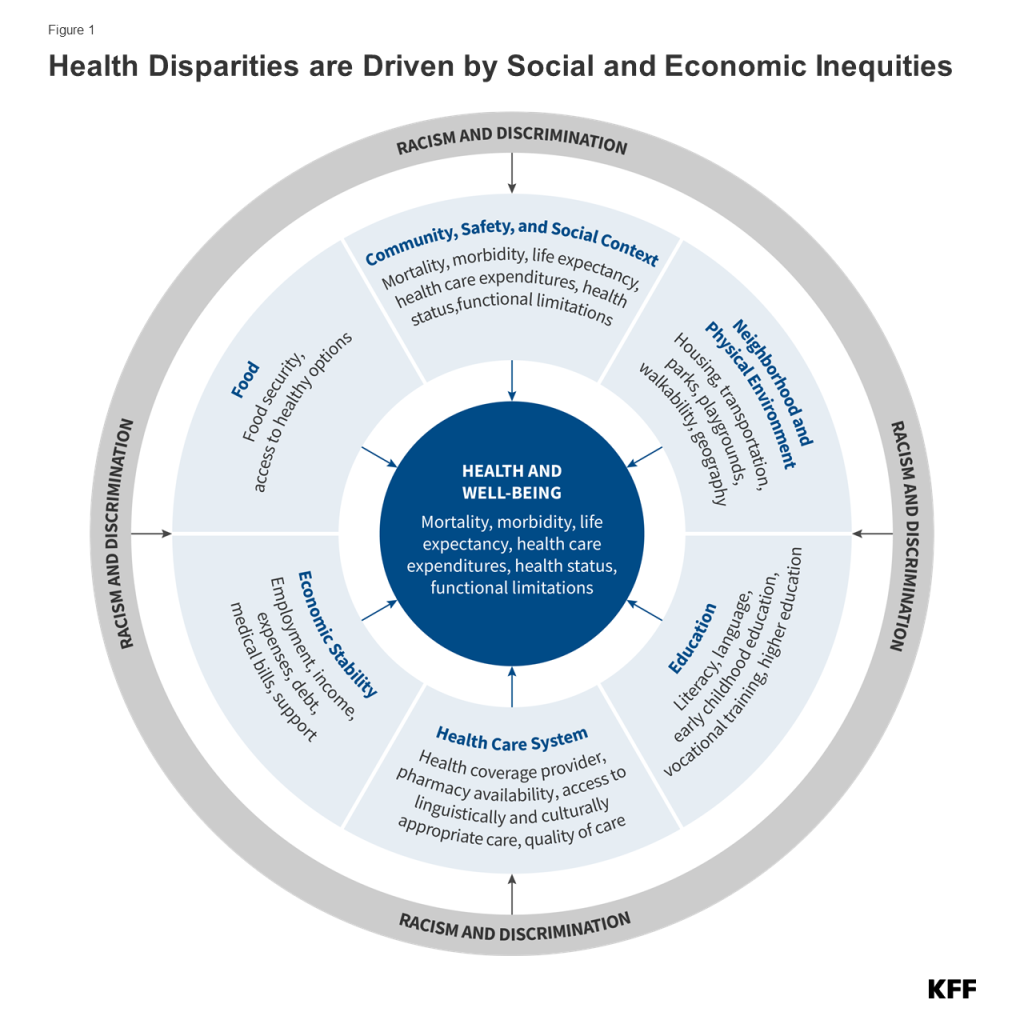
Health and health care disparities are often viewed through the lens of race and ethnicity, but they occur across a broad range of dimensions. For example, disparities occur across socioeconomic status, age, geography, language, gender, disability status, citizenship status, and sexual identity and orientation. Research also suggests that disparities occur across the life course, from birth, through mid-life, and among older adults. Federal efforts to reduce disparities focus on designated priority populations , including, “members of underserved communities: Black, Latino, and Indigenous and Native American persons, Asian Americans and Pacific Islanders and other persons of color; members of religious minorities; lesbian, gay, bisexual, transgender, and queer (LGBT+) persons; persons with disabilities; persons who live in rural areas; and persons otherwise adversely affected by persistent poverty or inequality.” These groups are not mutually exclusive and often intersect in meaningful ways. Disparities also occur within subgroups of populations. For example, there are differences among Hispanic people in health and health care based on length of time in the country, primary language, and immigration status . Data often also mask underlying disparities among subgroups within the Asian population.
Why is it important to address disparities?
Addressing disparities in health and health care is important not only from an equity standpoint but also for improving the nation’s overall health and economic prosperity . People of color and other underserved groups experience higher rates of illness and death across a wide range of health conditions, limiting the overall health of the nation. Research further finds that health disparities are costly, resulting in excess medical care costs and lost productivity as well as additional economic losses due to premature deaths each year.
What is the status of disparities today?
Disparities in health and health care are persistent and prevalent. Major recognition of health disparities began more than three decades ago with the Report of the Secretary’s Task Force on Black and Minority Health (Heckler Report) in 1985, which documented persistent health disparities that accounted for 60,000 excess deaths each year and synthesized ways to advance health equity. The Heckler Report led to the creation of the U.S. Department of Health and Human Services Office of Minority Health and influenced federal recognition of and investment in many aspects of health equity. In 2003, the Institute of Medicine’s Committee on Understanding and Eliminating Racial and Ethnic Disparities in Health Care released the report, Unequal Treatment: Confronting Racial and Ethnic Disparities in Health Care , which identified systemic racism as a major cause of health disparities in the United States. Despite the recognition and documentation of disparities for decades and overall improvements in population health over time, many disparities have persisted, and, in some cases, widened over time.
Beyond coverage, people of color and other marginalized and underserved groups continue to experience many disparities in accessing and receiving care . For example, people in rural areas face barriers to accessing care due to low density of providers and longer travel times to care, as well as more limited access to health coverage. There also are inequities in experiences receiving health care across groups. For example, the KFF/The Undefeated 2020 Survey on Race and Health , found that one in five Black adults and one in five Hispanic adults report being treated unfairly treatment due to their race or ethnicity while getting health care for themselves or a family member in the past year. Nearly one-quarter (24%) of Hispanic adults and over one in three (34%) potentially undocumented Hispanic adults reported that it was very or somewhat difficult to find a doctor who explains this in a way that is easy to understand in a 2021 KFF survey. Other KFF survey data from 2022 found that nearly one in ten (9%) of nonelderly adult women who visited a health care provider in the past two years said they experienced discrimination because of their age, gender, race, sexual orientation, religion, or some other personal characteristic during a health care visit. KFF data also showed that LGBT+ people were more likely than their non-LGBT+ counterparts to report certain negative experiences while getting health care, including a doctor not believing they were telling the truth, suggesting they are personally to blame for a health problem, assuming something about them without asking, and/or dismissing their concerns. The 2023 KFF/The Washington Post Trans Survey found that trans adults were more likely to report having difficulty finding affordable health care or a provider who treated them with dignity and respect compared to cisgender adults.
The COVID-19 pandemic has taken a disproportionate toll on the health and well-being of people of color and other underserved groups. Cumulative age-adjusted data showed that AIAN and Hispanic people have had a higher risk for COVID-19 infection and AIAN, Hispanic, and Black people have had a higher risk for hospitalization and death due to COVID-19. Beyond these direct health impacts, the pandemic has negatively impacted the mental health, well-being, and social and economic factors that drive health for people of color and other underserved groups, including LGBT+ people . As such, the pandemic may contribute to worsening health disparities going forward.
Concerns about mental health and substance use have increased since the onset of the pandemic, particularly among some groups. According to a 2022 KFF/CNN survey , 90% of the public think there is a mental health crisis in the U.S. today. Over the course of the pandemic, many adults reported symptoms consistent with anxiety and depression. Additionally, drug overdose deaths have sharply increased – largely due to fentanyl – and after a brief period of decline, suicide deaths are once again on the rise. These negative mental health and substance use outcomes have disproportionately affected some populations, particularly communities of color and youth. Drug overdose death rates were highest among AIAN and Black people as of 2021. Alcohol-induced death rates increased substantially during the pandemic, with rates increasing the fastest among people of color and people living in rural areas. From 2019 to 2021, many people of color experienced a larger growth in suicide death rates compared to their White counterparts. Additionally, self-harm and suicidal ideation has increased faster among adolescent females compared to their male peers. Findings from a 2023 KFF/The Washington Post survey found that more trans adults reported struggling with serious mental health issues compared to cisgender adults and were six times as likely as cisgender adults to have engaged in self-harm in the previous year (17% vs. 3%). There are also substantial disparities in mental health, including suicidality, among LGBT+ youth compared to their non-LGBT+ peers.
What are recent federal actions to address disparities?
In the wake of the COVID-19 pandemic, there has been a heightened awareness of and focus on addressing health disparities. The disparate impacts of COVID-19 and coinciding racial reckoning following the police killing of George Floyd contributed to a growing awareness of racial disparities in health and their underlying causes, including racism. Early in his presidency, President Biden issued a series of executive orders focused on advancing health equity, including orders that outlined equity as a priority for the federal government broadly and as part of the pandemic response and recovery efforts . Federal agencies were directed with developing Equity Action Plans that outlined concrete strategies and commitments to addressing systemic barriers across the federal government. In its Health Equity Plan, the Department of Health and Human Services (HHS) outlined a series of new strategies, including addressing increased pregnancy and postpartum morbidity and mortality among Black and AIAN women; addressing barriers that individuals with limited English proficiency face in obtaining information, services, and benefits from HHS programs; leveraging grants to incorporate equity consideration into funding opportunities, implementing equity assessments across its major policies and programs; investing in resources to advance civil rights; and expanding contracting opportunities for small, disadvantaged businesses. The plan builds on earlier efforts that included increasing stakeholder engagement, establishing the Office of Climate Change and Health Equity , and establishing the National Institutes of Health UNITE Initiative to address structural racism and racial inequities in biomedical research. Since the release of its Equity Action Plan, HHS has taken actions to extend postpartum coverage through Medicaid and CHIP; issued rules to strengthen patient protections, including nondiscrimination protections; and issued nondiscrimination guidance to ensure that telehealth services are accessible to people with disabilities and those with limited English proficiency.
The Centers for Medicare and Medicaid Services (CMS) released an updated framework to advance health equity, expand health coverage, and improve health outcomes for people covered by Medicare, Medicaid, CHIP, and the Health Insurance Marketplaces. The framework outlined five priorities including expanding the collecting, reporting, and analysis of standardized data on demographics and social determinants of health; assessing the causes of disparities within CMS programs and addressing inequities in policies and operations; building capacity of health care organizations and the workforce to reduce disparities; advancing language access, health literacy, and the provision of culturally tailored services; and increasing all forms of accessibility to health services and coverage. The Administration has also identified advancing health equity and addressing social determinants of health as key priorities within Medicaid and has encouraged states to propose Section 1115 Medicaid waivers that expand coverage, reduce health disparities, and/or advance “whole-person care.” States have increasingly requested and/or received approval for waivers that aim to advance equity . Further, a growing number of states have approved or pending waivers with provisions related to addressing health-related social needs , such as food and housing, often focused on specific populations with high needs or risks.
The Administration and Congress have taken a range of actions to stabilize and increase access to health coverage amid the pandemic. Early in the pandemic, Congress passed the Families First Coronavirus Response Act (FFCRA), which included a temporary requirement that Medicaid programs keep people continuously enrolled during the COVID-19 Public Health Emergency in exchange for enhanced federal funds. Primarily due to the continuous enrollment provision, Medicaid enrollment has grown substantially compared to before the pandemic, and the uninsured rate has dropped with differences in uninsured rates between people of color and White people narrowing. Coverage gains also likely reflected enhanced ACA Marketplace subsidies made available by the American Rescue Plan Act (ARPA) of 2021 and renewed for another three years in the Inflation Reduction Act of 2022, boosted outreach and enrollment efforts, a Special Enrollment Period for the Marketplaces provided in response to the pandemic, and low Marketplace attrition . Additionally, in 2019, the Biden Administration reversed changes the Trump Administration had previously made to public charge immigration policies that increased reluctance among some immigrant families to enroll in public programs, including health coverage. Most recently, the Consolidated Appropriations Act of 2023 included a requirement for all states to implement 12 months of continuous coverage for children, supporting their coverage stability. However, it also set the end of the broader Medicaid continuous enrollment provision for March 31, 2023, which could lead to coverage losses for millions of people, reversing recent coverage gains.
There have been growing federal efforts to address disparities in maternal health. Over the past few years, the Administration launched several initiatives focused on addressing inequities in maternal health. In April 2021, President Biden issued a proclamation to recognize the importance of addressing the high rates of maternal mortality and morbidity among Black people. At the end of 2021, the White House hosted its inaugural White House Maternal Health Day of Action during which areas of concern in maternal health outcomes were identified and the Administration announced actions aimed at solving the maternal health crisis. In June 2022, the Biden Administration released the Blueprint for Addressing the Maternal Health Crisis . The Blueprint outlines priorities and actions across federal agencies to improve access to coverage and care, expand and enhance data collection and research, grow and diversify the perinatal workforce, strengthen social and economic support, and increase trainings and incentives to support women being active participants in their care before, during and after pregnancy. In July 2022, CMS announced a Maternity Care Action Plan to support the implementation of the Biden-Harris Administration’s Blueprint for Addressing the Maternal Health Crisis. The action plan takes a holistic and coordinated approach across CMS to improve health outcomes and reduce inequities for people during pregnancy, childbirth, and the postpartum period. ARPA included an option, made permanent in the Consolidated Appropriations Act , to allow states to extend Medicaid postpartum coverage from 60 days to 12 months. As of April 2023, the majority of states have taken steps to extend postpartum coverage. The Human Resources and Services Administration also announced $12 million in awards for the Rural Maternal and Obstetrics Management Strategies Program (RMOMS), which is designed to develop models and implement strategies to improve maternal health in rural communities.
The Administration has also taken steps to address health disparities and discrimination experienced among LGBT+ people. On his first day in office, President Biden signed an Executive Order on “Preventing and Combating Discrimination on the Basis of Gender Identity or Sexual Orientation.” Since then, the Administration has taken multiple actions to address discrimination within health care specifically. In May 2021, the Biden Administration announced that the HHS Office for Civil Rights (OCR) would include gender identity and sexual orientation as it interprets and enforces the ACA’s prohibition against sex discrimination (Section 1557), reversing the approach taken by the Trump Administration. Additionally, the Administration has spoken out against state actions aimed at curtailing access to gender affirming care for transgender and gender nonconforming people, particularly policies targeting youth. In January 2023, the Administration released its Federal Evidence Agenda on LGBTQI+ Equity , a “roadmap for federal agencies as they work to create their own data-driven and measurable SOGI Data,” which the Administration views as central to understanding disparities and discrimination facing this community.
What are key issues related to health disparities looking ahead?
The end of the Medicaid continuous enrollment provision may lead to coverage losses and widening disparities. Following the ending of the Medicaid continuous enrollment provision on March 31, 2023, states resumed Medicaid redeterminations. KFF estimates that between 5 and 14 million people could lose Medicaid coverage, including many who newly gained coverage during the pandemic. Other research shows that Hispanic and Black people are likely to be disproportionately impacted by the expiration of the continuous enrollment provision. Moreover, some groups, such as individuals with limited English proficiency and people with disabilities may face increased challenges in completing the Medicaid renewal process increasing their risk of coverage loss even if they remain eligible for coverage. OCR has reminded states of their obligations under federal civil rights laws to take reasonable steps to provide meaningful language access for individuals with limited English proficiency and ensure effective communication with individuals with disabilities to prevent lapses in coverage amid the unwinding of the continuous enrollment provision. CMS issued guidance that provides a roadmap for states to streamline processes and implement strategies to reduce the number of people who lose coverage even though they remain eligible. The extent to which states simplify processes to renew or transition to other coverage and provide outreach and assistance to individuals more likely to face challenges completing renewal processes will impact coverage losses and potential impacts on coverage disparities.
The end of the COVID-19 Public Health Emergency (PHE) and the potential depletion of the federally purchased supply of COVID-19 vaccines, treatments, and tests may curtail access to these supplies for some individuals, particularly those who are uninsured. In response to the COVID-19 pandemic, the federal government spent billions of dollars in emergency funds to purchase COVID-19 vaccines, including boosters, treatments, and tests to provide free of charge to the public. In addition, Congress enacted legislation that included special requirements for their coverage by both public and private insurers, and the Administration issued guidance and regulations to protect patient access and promote equitable distribution. The upcoming end to the PHE on May 11, 2023, as well as the potential depletion of federally purchased supplies in the absence of any additional funding, could result in new or higher cost-sharing and/or reduced access to these products although these impacts may vary by product and the type of health coverage an individual has. People who are uninsured or underinsured face the greatest risk of access challenges, including limited access to free vaccines and no coverage for treatment or tests. Since people of color and people with lower incomes are more likely to be uninsured, they may be at a disproportionate risk of facing barriers to accessing COVID-19 vaccines, tests, and treatments once the PHE ends and the federal supply is depleted.
The overturning of Roe v. Wade may exacerbate the already large racial disparities in maternal and infant health. The decision to overturn the longstanding Constitutional right to abortion and elimination of federal standards on abortion access has resulted in growing variation across states in laws protecting or restricting abortion. These changes may disproportionately impact women of color, as they are more likely to obtain abortions, have more limited access to health care, and face underlying inequities that would make it more difficult to travel out of state for an abortion compared to their White counterparts. Restricted access to abortions may widen the already stark racial disparities in maternal and infant health, as some groups of color are at higher risk of dying from pregnancy-related reasons and during infancy and are more likely to experience birth risks and adverse birth outcomes compared to White people. It may also have negative economic consequences associated with the direct costs of raising children and impacts on educational and employment opportunities. Further, women from underserved communities may be at increased risk for criminalization in a post-Roe environment, as prior to the ruling, there were already cases of women being criminalized for their miscarriages, stillbirths, or infant death, many of whom were low-income or women of color.
Many states have implemented policies banning or limiting access to gender affirming care, especially for youth, as well as other legal actions that threaten access to care for LGBT+ people . Policies aimed at limiting access to gender affirming care may have significant negative implications for the health of trans and nonconforming people, particularly young people, including negative mental health impacts, and an increased risk of suicidality . Additionally, the recent Braidwood case on preventive care access directly affects LGBT+ people in its treatment of Pre-Exposure Prophylaxis (PrEP). It relies, in part, on religious protections arguments to limit access to the drug based on the plaintiff’s claim that it “facilitate[s] and encourage[s] homosexual behavior, prostitution, sexual promiscuity, and intravenous drug use.” If PrEP use declines as a result of the Braidwood decision, HIV incidence could increase , likely disproportionally impacting people of color and LGBT+ people. Efforts to curtail access to gender affirming care and the Braidwood decision are at odds with the Administration’s stated approach to health equity for LGBT+ people. How such policies play out in the longer term will be determined largely by the courts.
Evolving immigration policies may impact the health and well-being of immigrant families. When the PHE ends on May 11, 2023, Title 42 restrictions that suspended the entry of individuals at the U.S. border to protect public health during the COVID-19 emergency are expected to terminate. It is anticipated that when the authority ends, there will be an increase in immigrant activity at the U.S. border. The Biden Administration has announced plans to increase security and enforcement at the border to reduce unlawful crossings, expand “legal pathways for orderly migration”, invest additional resources in the border region, and partner with Mexico to implement the aforementioned plans. However, it remains to be seen how shifting policies will impact trends at the border and health and health care in that region. The future of the Deferred Action for Childhood Arrivals (DACA) program remains uncertain, and its implementation is currently limited subject to court orders . If the DACA program is found to be unlawful in pending court rulings, individuals would lose their DACA status and subsequently their work authorizations. The loss of status and work authorization may result in loss of employer-based health coverage, leaving people uninsured and unable to qualify for Medicaid, CHIP, or to purchase coverage through the Marketplaces. Additionally, although the Biden Administration reversed public charge regulations implemented by the Trump Administration as part of an effort to address immigration-related fears that limited immigrant families’ participation in government assistance programs, including Medicaid and CHIP, many families continue to have fears and concerns about enrolling in these programs, contributing to ongoing gaps in coverage for immigrants and children of immigrants.
Growing mental health and substance use concerns and ongoing racism, discrimination, and violence may contribute to health disparities. As previously noted, mental health and substance use concerns have increased since the onset of the pandemic, with some groups particularly affected. These trends may lead to new and widening disparities. For example, people of color have experienced larger increases in drug overdose death rates than White people, resulting in the death rate for Black people newly surpassing that of White people by 2020. Further, Black and Asian people have reported negative mental health impacts due to heightened anti-Black and anti-Asian racism and violence in recent years. Research has documented the negative health impacts, including negative impacts on mental health and well-being, of exposure to violence, including police and violence. Research shows African American and AIAN men and women, and Latino men are at increased risk of being killed by police compared to their White peers. Black and Hispanic adults also are more likely than White adults to worry about gun violence according to 2023 KFF survey data . Other KFF analysis shows that firearm death rates increased sharply among Black and Hispanic youth during the pandemic driven primarily by gun assaults and suicide by firearm. Research further shows that repeated and chronic exposure to racism and discrimination is associated with negative physical and mental health outcomes , including premature aging and associated health risks, referred to as “ weathering ,” as well as higher mortality .
Despite growing mental health concerns, people of color continue to face disproportionate barriers to accessing mental health care. Research suggests that structural inequities may contribute to disparities in use of mental health care, including lack of health insurance coverage and financial and logistical barriers to accessing care, stemming from broader inequities in social and economic factors . Lack of a diverse mental health care workforce, the absence of culturally informed treatment options, and stereotypes and discrimination associated with poor mental health may also contribute to limited mental health treatment among people of color. Amid the pandemic, many states implemented telehealth behavioral health services to expand access to behavioral health care, and most states intend to keep these services. States are also adopting strategies to address workforce shortages in behavioral health. As states seek to expand access to behavioral health care, it will be important to ensure that services address the cultural and linguistic needs of diverse populations. Further, in 2022, the federal government mandated the suicide and crisis lifeline number that provides a single three-digit number (988) to access a network of over 200 local and state-funded crisis centers. The 988 number is expected to improve the delivery of mental health crisis care; however, it is unknown how well it will address the needs of people of color and other underserved populations.
In sum, disparities in health and health care for people of color and other underserved groups are longstanding challenges, many of which are driven by underlying structural and economic disparities rooted in racism. Addressing disparities is key not only from an equity standpoint but for improving the nation’s overall health and economic prosperity. Amid the COVID-19 pandemic, the federal government identified health equity as a priority and has since launched initiatives to address disparities wrought by the COVID-19 pandemic and more broadly. Alongside the federal government, states, local communities, private organizations, and providers have engaged in efforts to reduce health disparities. Moving forward, a broad range of efforts both within and beyond the health care system will be instrumental in reducing disparities and advancing equity.
- Racial Equity and Health Policy
- Coronavirus (COVID-19)
- Women's Health Policy
- Access to Care
- American Indian/Alaska Native
- Race/Ethnicity
Also of Interest
- How History Has Shaped Racial and Ethnic Health Disparities: A Timeline of Policies and Events
- Key Data on Health and Health Care by Race and Ethnicity
- Health Coverage by Race and Ethnicity, 2010-2022

- Request new password
- Create a new account
Multiple Choice Questions
Research methodology.
9 Best WordPress Translation Plugins in 2024 (Free and Paid)
Pricing: €39 per year Standout Features: Premium WP Translation, SEO-Friendly URLs, Translation Management

- TranslatePress
Pricing: €89 per year Standout Features: Front-End Translation, Multilingual SEO, Visual Translation Interface

Pricing: €15 per month Standout Features: Quick Installation, Automatic Content Detection, AI-Powered SEO
WordPress is the most popular CMS globally, but its reach is limited if your content is in multiple languages. WordPress translation plugins are a simple and elegant solution to that problem. With tools like these plugins and themes with built-in translation and multi-language support, making your site accessible to a much larger audience can take minimal effort.
This article will introduce you to the best WordPress translation plugins currently available and highlight some of their best features.
Let’s get into it!
- 1 Why Use a WordPress Translation Plugin
- 2.1 1. WPML
- 2.2 2. TranslatePress
- 2.3 3. Weglot
- 2.4 4. Multilanguage
- 2.5 5. GTranslate
- 2.6 6. Loco Translate
- 2.7 7. Polylang and Lingotek
- 2.8 8. Google Website Translator
- 2.9 9. Multisite Language Switcher
- 3.1 Translation Plugin Price Comparison
- 3.2 Top 3 Translation Plugins: Feature Comparison
- 4 What Is The Best WordPress Translation Plugin?
- 5 Frequently Asked Questions (FAQs)
Why Use a WordPress Translation Plugin
When you create your WordPress site, you can set your preferred language in the native dashboard. Go to Settings and then General , then scroll down to Site Language. Choose your preferred dashboard language from the drop-down menu.
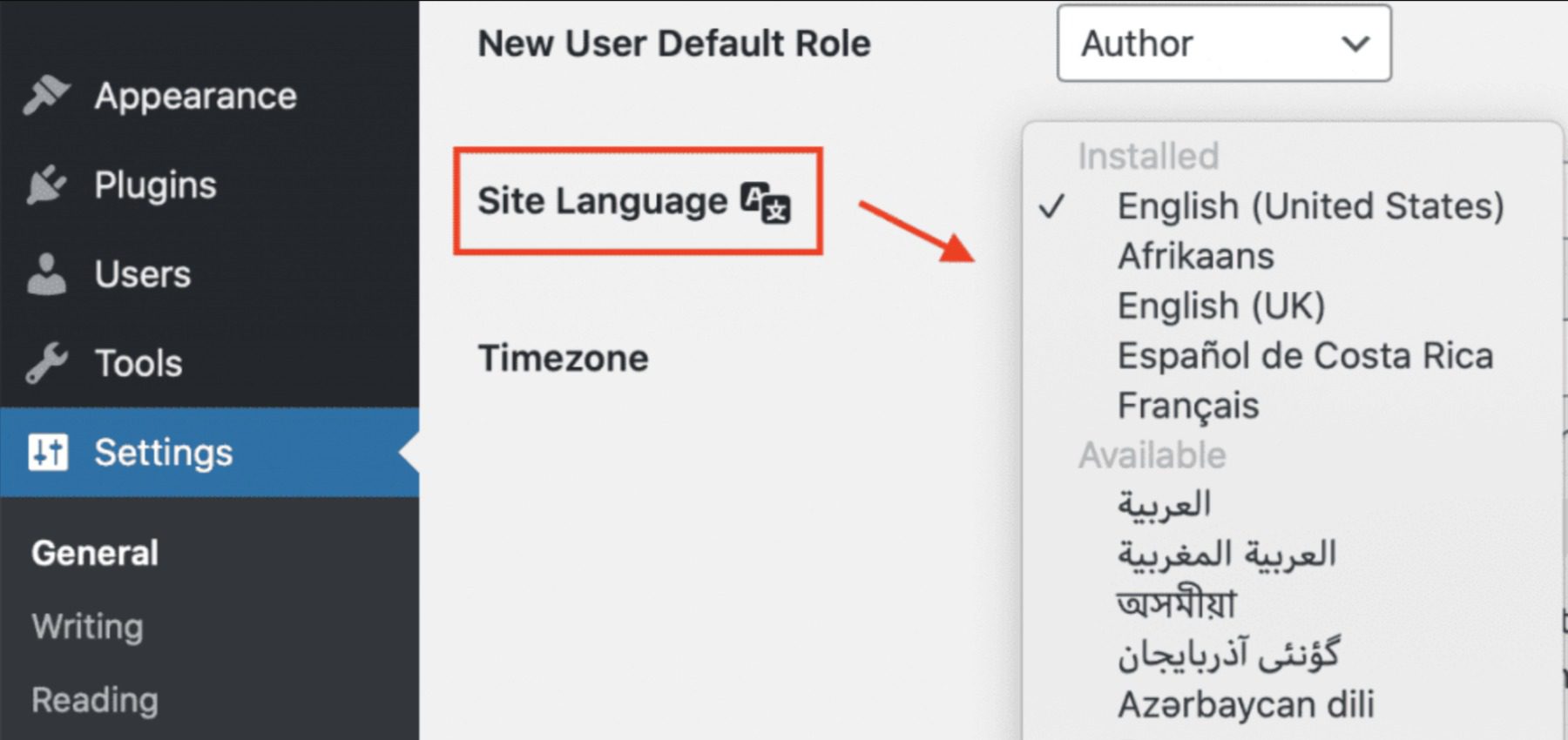
While this will change the language of your dashboard, you’ll need a plugin if you want to create multilingual websites. These plugins eliminate the need to set up multiple WordPress subdomains and instead turn your website into a multilingual platform .
There are two types of translation plugins:
- Auto Translations
- Manual Translations
Auto-translations will automatically translate preexisting content from your website to your users’ preferred language but will sacrifice some accuracy (Google translate levels of accuracy.) On the other hand, Manual translations let your users view the languages you have transcribed manually, which sacrifices speed and convenience for accuracy and customizability.
The Best Translation WordPress Plugins
The Best WordPress Translation Plugins Listed In Order
- Multilanguage
- Loco Translate
- Polylang and Lingotek
- Google Website Translator
- Multisite Language Switcher
Now that we better understand what a translation plugin can do, let’s get into our top choices for best translation WordPress plugins.
🥇Best WordPress Translation Plugin Overall

While there are many free options for WordPress translation plugins, WPML (or WordPress Multilingual) is a premium plugin and service that covers everything you need for translation. One of the driving forces behind WPML is that it is an all-in-one solution to translation that you get control of, not your readers’ machines. Not every site out there will need the entire WPML platform (for instance, a small personal blog may be fine to rely on Google Translate). Still, sites with a significant international presence often need more than what a simple auto-generated, machine-created translation can offer.
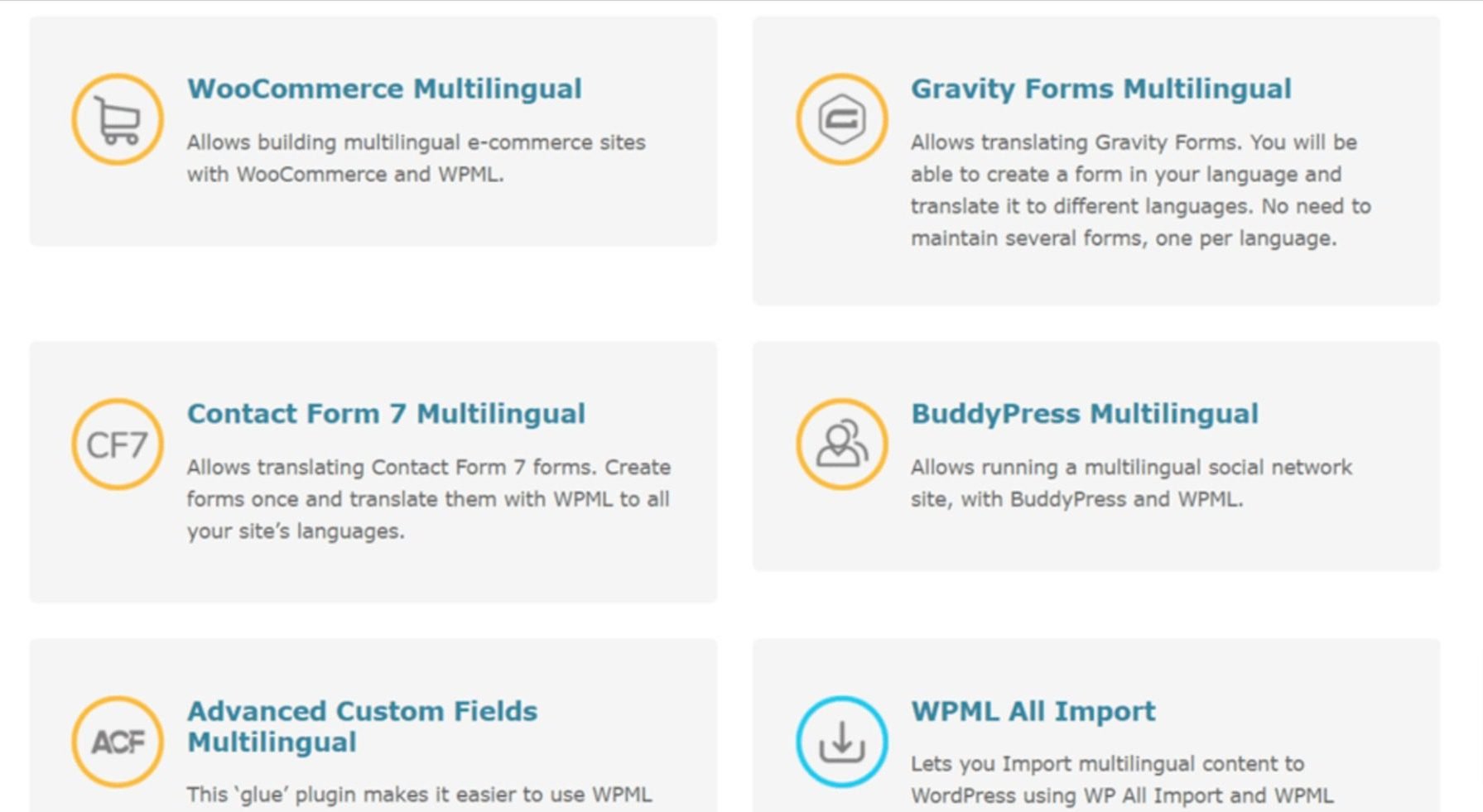
With that control comes compatibility with popular WordPress themes (like Divi) and major plugins and services you may already use. From WooCommerce to Gravity Forms, Contact Form 7, and Advanced Custom Fields (and more!), you can use WPML to translate them and their output for your customers. With fine control over which languages and what translations are used, you won’t need to worry about your products being presented incorrectly or your forms being labeled incoherently.
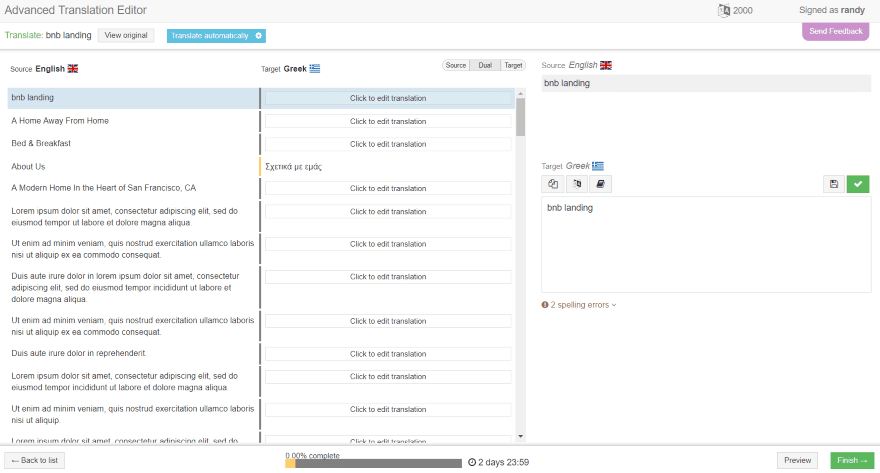
What We Liked About WPML
- Full control over URLs: You can customize the URLs of your translated pages and posts to make them more SEO-friendly. This feature helps search engines understand your site’s structure and drive the right traffic to the right languages.
- SEO meta information: You can set SEO meta information for translations, such as title tags and meta descriptions, to help search engines understand the content of your translated pages and posts.
- Translation management: WPML provides a system that allows you to manage all your translations in one place. You can assign translation jobs to translators, track the progress of translations, and review completed translations.
- Multilingual e-commerce: WPML is compatible with WooCommerce and other popular e-commerce plugins, allowing you to create multilingual online stores easily.
- Translation for every element: WPML lets you translate every element of your WordPress site, including navigation, widgets, pages, articles, custom post types, or any other element. WPML also supports the Gutenberg editor.
What Could Be Improved
- Complex Setup: Setting up WPML can be complicated, especially for beginners. Rolling out multiple languages may take time.
- Potential Page Load Impact: WPML can slow page load times, especially with significant content or installed plugins.
- Code Bloat: WPML adds additional code to your WordPress site, which may affect performance.
🥇Why We Picked It
WPML has been around for a long time and remains one of the most reliable multilingual solutions to date. It offers a range of features, including manual and automatic translation options, SEO optimization, and compatibility with a wide range of WordPress themes and plugins.
Who Is WPML Best For?
WPML is best suited for large-scale businesses and professional translators. It offers a comprehensive translation management system that allows users to translate all types of content, including custom post types, taxonomies, and menus.
Community Reviews and Ratings
Users like WPML because it’s easy to use and helps websites speak many languages. Reviews on G2 and Capterra say it’s great for managing translations smoothly.

WPML is a premium-only plugin. Tiers start at €39 per year (~$43) for a single site with basic functions. They can go up to €199 per year (~$218) for unlimited sites and access to all features.
2. TranslatePress
🥈best wordpress translation plugin for ease of use.

TranslatePress works a little differently than other WordPress translation plugins. It doesn’t require the website’s backend to work with the translations. This plugin gives a real-time look at the translations you provide, working almost like a page-builder to ensure that your site looks and feels the same to everyone, regardless of the language they see on your site.
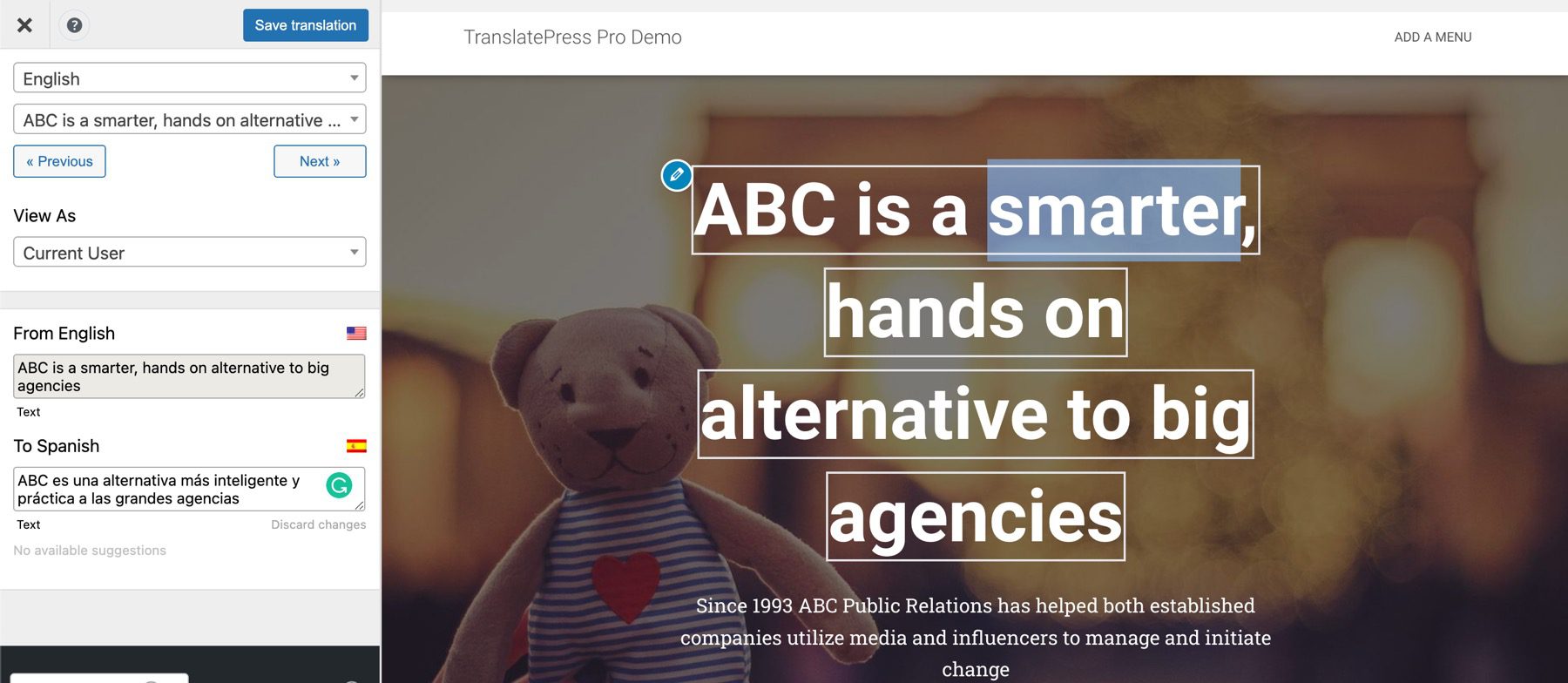
By giving this level of control, TranslatePress allows users to be specific about which elements of their websites get translated manually or automatically. One of the other highlights of TranslatePress is that this feature, among many others, comes in the free version. Paid upgrades unlock access to add-ons, extensions, and more advanced features.
What We Liked About TranslatePress
- Front-end Translation: TranslatePress allows you to translate your WordPress site directly from the front end, with full support for WooCommerce, complex themes, and site builders. You can translate your website without switching between the editor, string translation interfaces, or badly translated plugins. You work with the final page directly from the front end, with full support for WooCommerce and site builders.
- Automatic Translation: TranslatePress is integrated with Google Translate and DeepL, allowing you to quickly get your content automatically translated and only adjust what’s imperfect. This feature accelerates the translation process and saves you time.
- Multilingual SEO: TranslatePress supports SEO for page slug, page title, description, X (formerly known as Twitter), and Facebook social graph information. The HTML lang attribute is properly set. Sitemap support is available for all popular SEO plugins.
- Visual Translation Interface: TranslatePress has the simplest translation interface you can hope for. It works with any theme or plugin and allows you to translate the entire page simultaneously, including output from shortcodes, forms, and page builders. You can also translate images, sliders, and other media.
- GPL and Self-hosted: TranslatePress is GPL and self-hosted. This means that you own your translations forever. The yearly license gives you access to updates, new features, and support. After the license expires, your site will continue to work as expected.
- Performance Impact: Depending on your website’s size and the number of translations, TranslatePress may impact performance if not optimized properly.
- Poor Machine Translation Quality: While TranslatePress has integrated with Google Translate and DeepL, the machine translation quality may not be perfect. It is always recommended to review the machine-translated content and make necessary adjustments.
- Resource Intensive: Real-time front-end translation could slow down your website, especially if you have dynamic content.
🥈Why We Picked It
TranslatePress shines with its intuitive interface and visual translation editor, making it ideal for beginners and non-technical users. Its focus is on user experience and accessibility for a wider audience. It boasts minimal performance impact, ensuring your website remains fast and responsive even in multiple languages.
Who Is TranslatePress Best For?
TranslatePress is best suited for small businesses and bloggers. It offers a simple and intuitive visual translation interface that allows users to translate their website content directly from the front end.
TranslatePress is praised on G2 and Capterra because it lets you translate from your website’s front page. Users find it simple and easy.
TranslatePress has a free plan , with costs arising from core translation features. Paid plans start at €89 per year (~$97.50).
Get TranslatePress
🥉 Best WordPress Translation Plugin For Cloud-Based Convenience
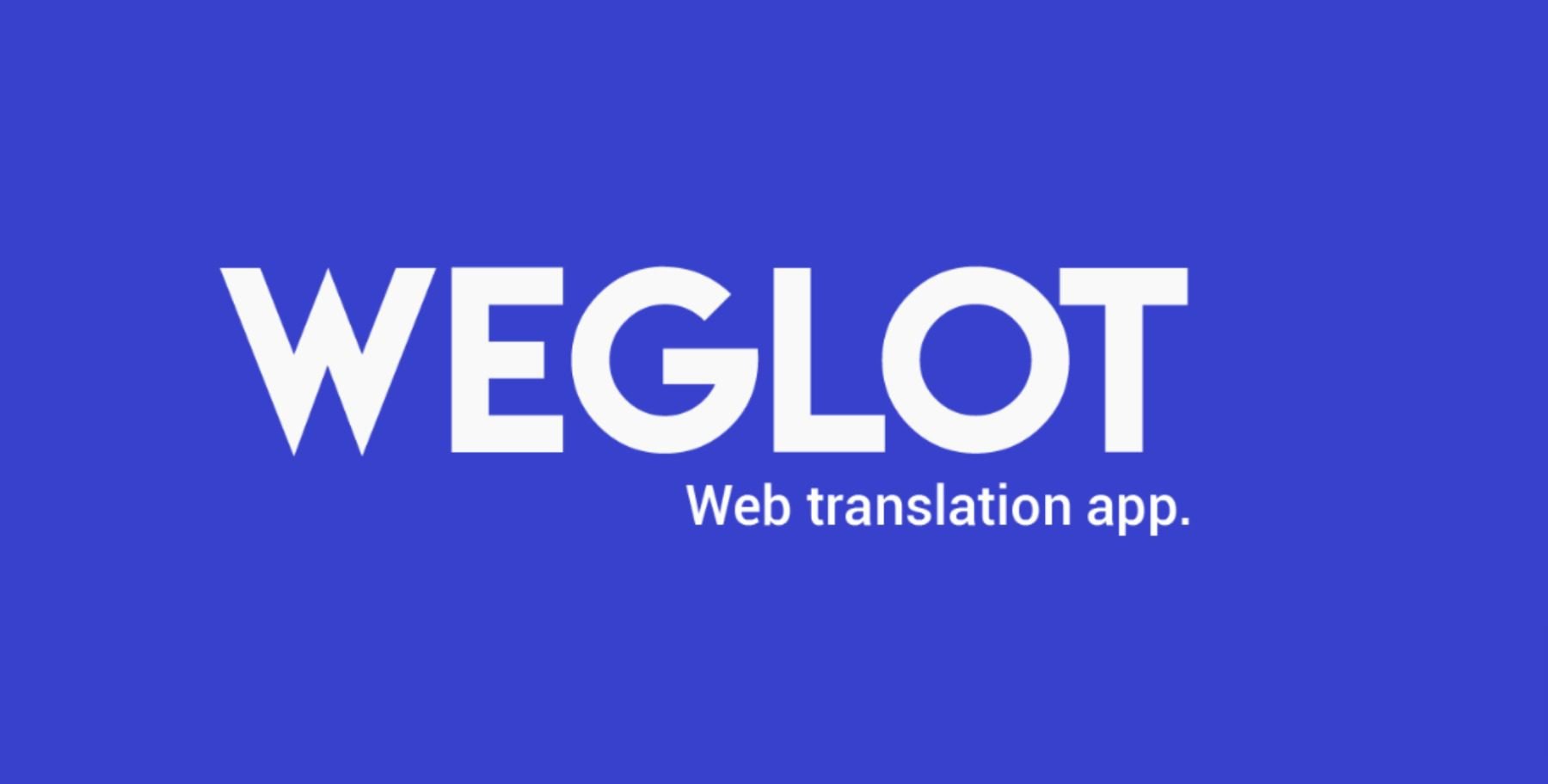
A major issue with multilingual websites is that each translation takes up space on the server, in your post and page list, and requires manual management. With Weglot , that’s not an issue. The plugin takes your media and content, even the content pulled from third-party sources, and translates it automatically. Meaning there is no need to maintain multiple identical and duplicate websites.
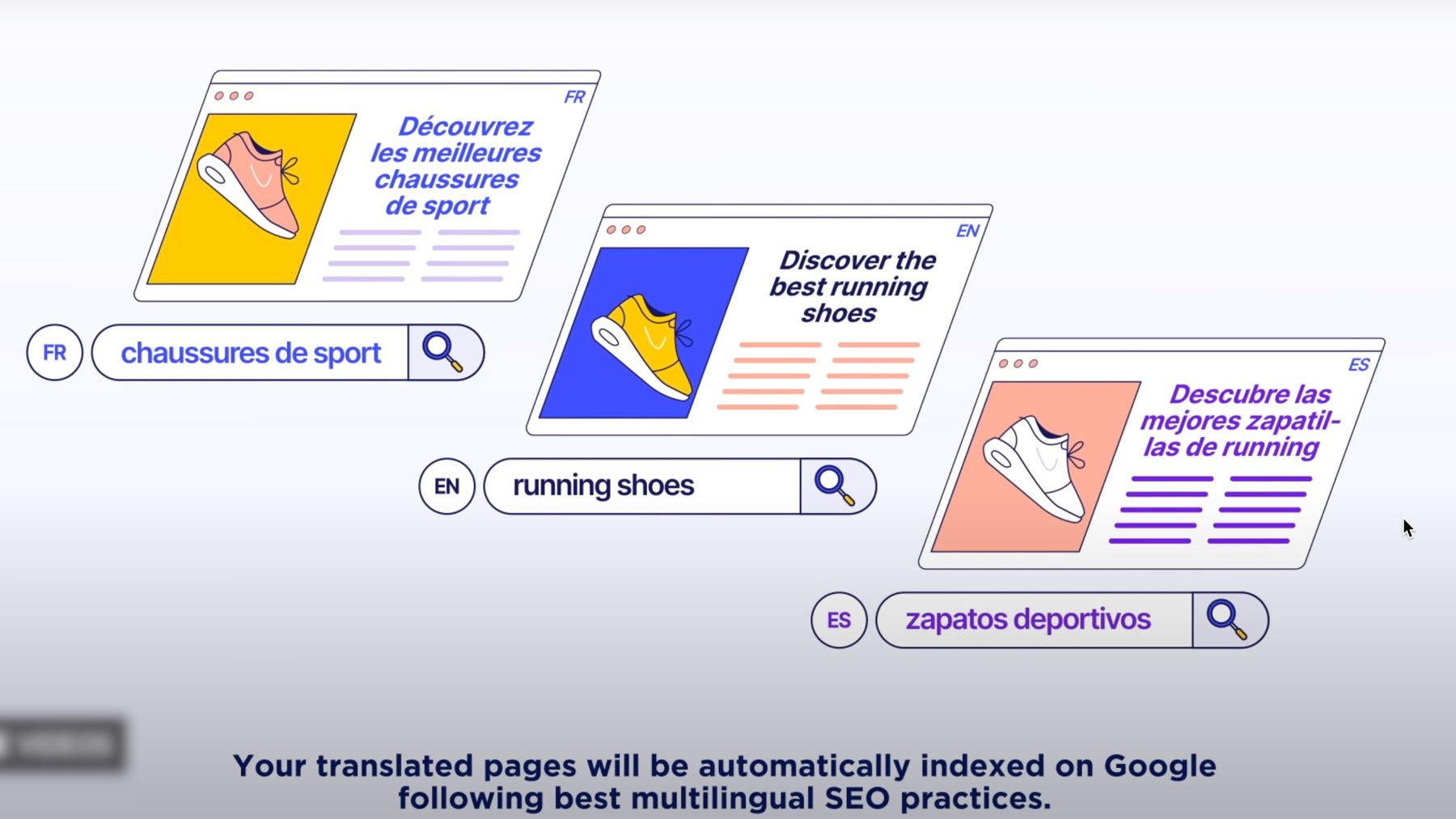
An interesting feature of Weglot is the ability to set guidelines for what you want the translation on your site to look like. You can set it to a fast translation, relying on Google, Yandex, and DeepL (among others) to translate your site automatically. You can take full control and manually enter your translations for specific languages. And if you have the budget and need, a human translator can work on the most accurate content possible. Weglot also provides a glossary of phrases and terms (your brand name, for instance) never to translate so it stays consistent across the site.
What We Liked About Weglot
- Quick and Easy Installation: Weglot can be installed in minutes without any coding experience or shortcuts required. You can select your languages and start translating your site within 5 minutes (or less).
- Automatic Content Detection: Weglot automatically detects your website content for translation, including posts, pages, menus, eCommerce products, widgets, headers, sidebars, popups, and more.
- All-in-One Translation Interface: Weglot provides a user-friendly interface to review your translated content. You can order professional translators, add teammates for human translation, and refine your automatic translations for impactful website localization. Plus, you can see your edits in real time through their Visual Editor.
- Multilingual SEO: Weglot follows Google’s SEO best practices to maximize your searchability across different languages and search engines. Through AI-powered machine translation, it translates all of your metadata and automatically adds hreflang tags. Even better, Weglot automatically translates SEO tags added by SEO plugins.
- Compatibility: Weglot is compatible with every WordPress theme, plugin, and add-on, including page builders (Elementor, Divi), Yoast SEO, and WooCommerce.
- Accuracy in Translation: Although Weglot uses machine translation, it is not always accurate and may require manual editing. It would be great if they could improve their machine translation algorithms to provide more accurate translations.
- Support: You may report issues with Weglot’s customer support, citing slow response times and unhelpful responses. It would be great if they could improve their customer support to provide more timely and effective assistance.
🥉Why We Picked It
Weglot offers a cloud-based solution, eliminating the need for complex plugin installations and updates. This showcases your appreciation for user convenience and streamlined workflows. Moreover, it excels in automatic translation, offering a fast and easy way to translate your website content.
Who Is Weglot Best For?
Weglot is best suited for e-commerce websites and online stores. It offers a simple and intuitive interface, allowing users to translate their website content into multiple languages quickly.
Users on G2 and Capterra love Weglot because it uses smart technology to translate websites quickly. It’s popular for making websites multilingual without much hassle.
Weglot has a free plan, with costs arising from core translation features. Paid plans start at €15 per month (~$16.50) or €150 per year .
4. Multilanguage

Multilanguage is a very powerful WordPress translation plugin. Still, it is mostly designed for those users who already have a translation of their site and need a way to implement it. While this plugin does support automatic Google translation, the big draw is the ease with which you can provide your translations to posts and pages, categories, menus, and tags.
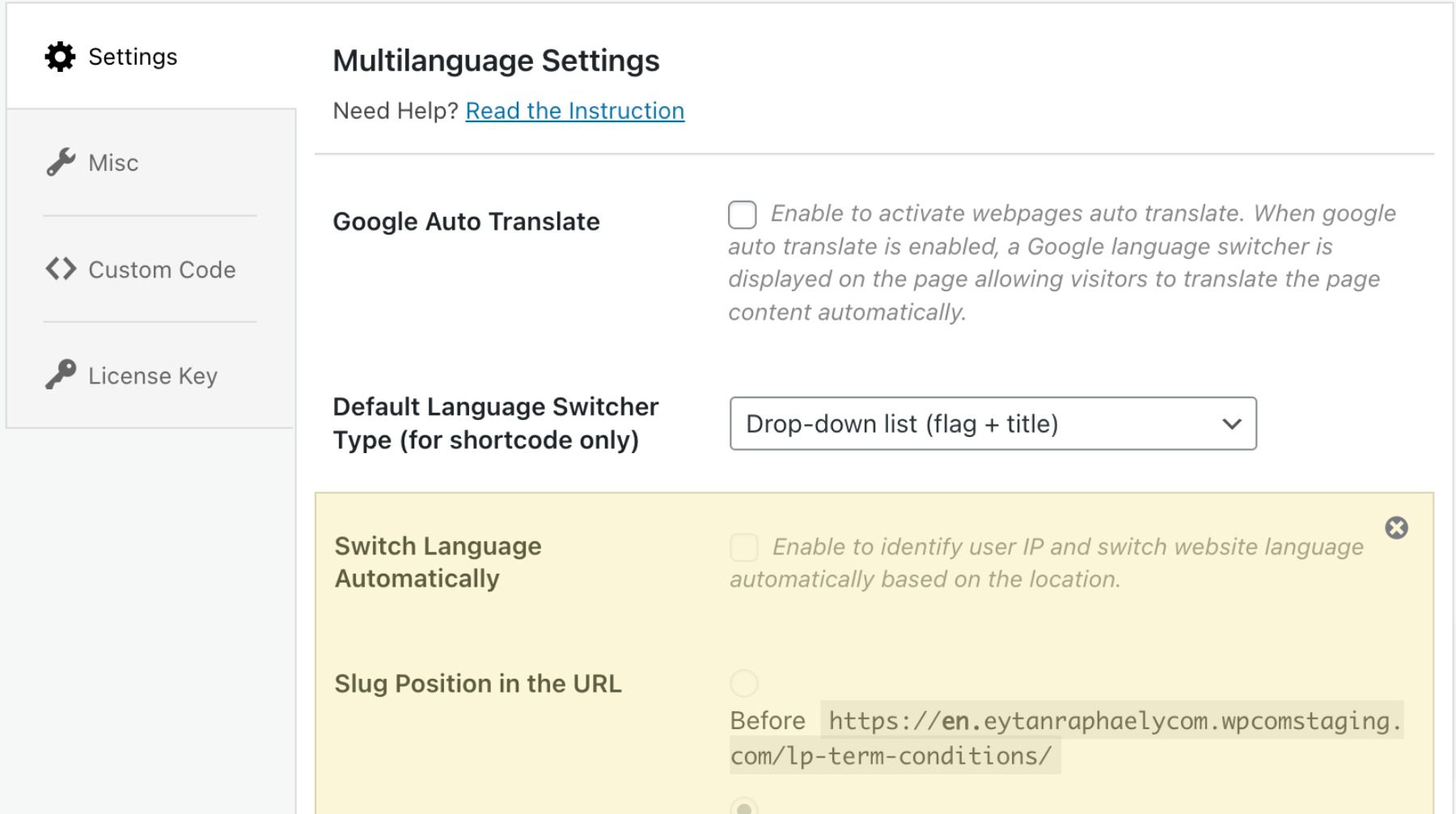
The free version of the plugin can handle what most blogs and sites need for translation. Still, suppose you need more than what comes for free. In that case, the Pro upgrade includes translations for WordPress taxonomies, page builder compatibility, custom fields, and language slug position changes (such as en.example.com versus example.com/en ).
What We Liked About Multilanguage
- Simple settings: Multilanguage has simple settings that make it easy to set up without modifying code. You can set up your multilingual website quickly and easily.
- Block Editor Compatible: Multilanguage is compatible with the latest WordPress version and supports the block editor (Gutenberg).
- Translation-ready admin dashboard: The plugin provides an admin dashboard ready for translation. You can translate the admin dashboard into your preferred language.
- Flexibility for Developers: Multilanguage allows you to add custom code via its plugin settings page. This means that you can customize the plugin to suit your needs.
- Hide link slug for the default language: Multilanguage allows you to hide the link slug for the default language. You can have a cleaner URL structure for your default language.
- Supports hreflang links: Multilanguage enables you to add hreflang links to your content to improve SEO.
- Limited language support: Multilanguage supports a limited number of languages compared to other plugins.
- No automatic translation feature: Unlike other translation plugins, Multilanguage has no automatic translation feature. This means you will need to translate your content manually or use a third-party service.
- No support for WooCommerce: Multilanguage does not support WooCommerce, a popular WordPress plugin for eCommerce websites.
Who Is Multilanguage Best For?
Multilanguage is ideal for website owners who need a basic solution for creating a bilingual or multilingual site. It offers a simple interface for managing translations. It’s perfect for beginners who want to get started quickly. If you’re catering to a specific region or ethnic group and need only a few translations, Multilanguage can handle that without overwhelming you.
On the WordPress repository, users think Multilanguage is helpful because it supports many languages and is easy to use. It’s good for making websites in different languages.

Multilanguage has a free plan, with costs arising from core translation features. Paid plans with a Pro upgrade start at $39 per year .
Get Multilanguage
5. GTranslate

Most internet users are familiar with Google Translate. If you’re a Chrome user, there’s a good chance you’ve had a modal pop-up asking if you want a page translated from X language to your native tongue. Or perhaps you’ve copied/pasted some text into the Google search bar, and Google spat out an automatic translation. That’s the same technology that Gtranslate uses at its base.
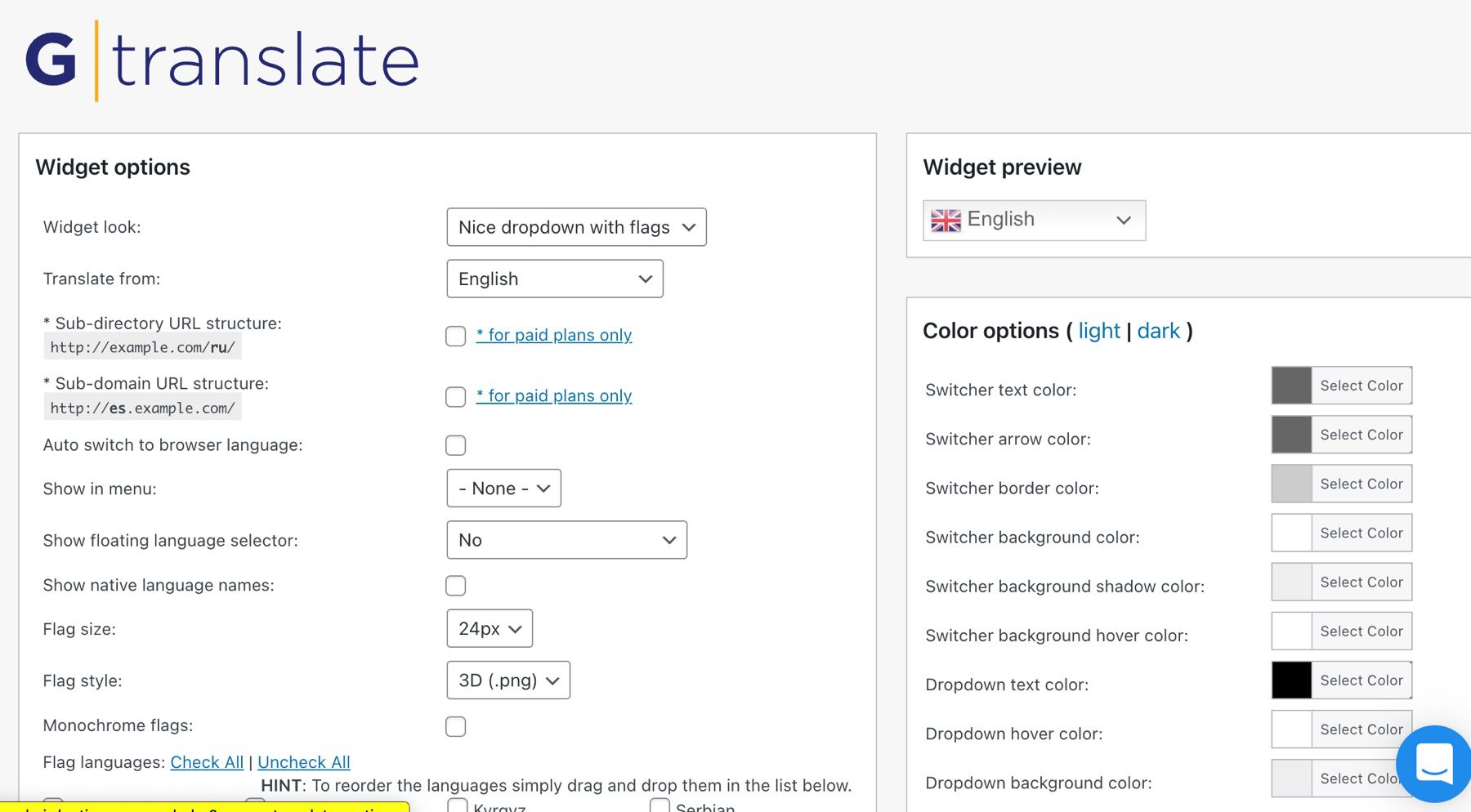
The most useful part of GTranslate is the ability for visitors to choose which translation they want. Because the free version uses Google’s machine translation, not every single page may convey the exact information in the exact that you want. Or that is technically understandable by the reader. This isn’t a fault of WordPress translation plugins, just the nature of translation itself. However, by providing the user a choice between translations, those polyglots who find your site will surely be able to find a translation that works for them.
What We Liked About GTranslate
- In-context Corrections: This feature allows you to make corrections without losing the context of your translated content.
- Metadata translation: GTranslate can translate meta keywords and meta descriptions, which can help improve your website’s search engine appearance.
- Schema.org Microdata Translation: GTranslate supports schema.org microdata translation, which can also help improve your website’s search engine appearance.
- Seamless Updates and Backups: GTranslate is a cloud-based service that is updated on their side, so you don’t need to worry about backups on your side.
- Translation quality: Although GTranslate supports Neural Machine Translation (NMT) technology, which is more advanced than the previous statistical machine translation (SMT) technology, it still has room for improvement in accuracy and naturalness.
- Internet Dependency: GTranslate requires an internet connection. This limitation can be problematic if you’re in a rush with limited internet access.
- No Search Engine Indexing with Free Version: The free version has great core features, but if you want search engines to crawl your translated content, you will need a paid version.
GTranslate caters to website owners who want automatic translations using online services. It provides machine-generated translations, making translating your content into various languages effortless. Users can choose from a broad range of languages.
GTranslate is praised on G2 and the WordPress repository for its easy translation and customizable language switcher. People like it for making websites speak different languages smoothly.
GTranslate has a free plan. But if you want search engine indexing, paid plans start at $9.99 per month .
Get GTranslate
6. Loco Translate

Loco Translate is fast and lightweight but also feature-rich. Developers can also love what Loco Translate offers. They can tie into multiple language APIs like DeepL, Google, Microsoft, and Yandex. Additionally, the plugin allows website owners to update their language files directly from the theme itself (or the plugin) without going through a cloud host. Because of this, you can extract translatable strings from your source code to bring specific parts of your site to life for everyone.
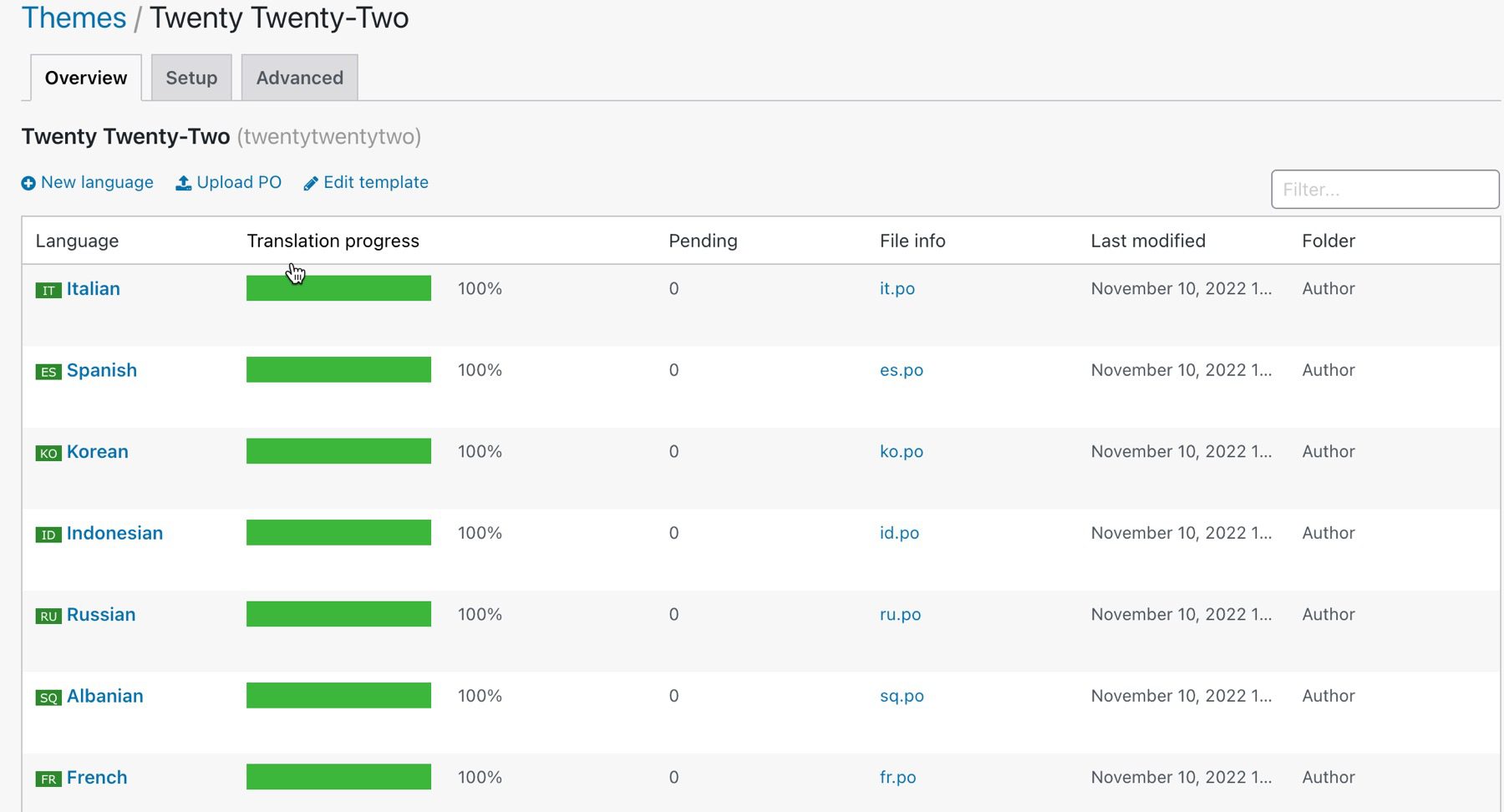
With over a million active users and a 5-star review, this is one of the most trusted plugins on the list and should be considered if you are trying to translate your WordPress themes/plugins.
What We Liked About Loco Translate
- Built-in translation editor: Loco Translate provides a built-in translation editor within the WordPress admin, which allows you to edit translation files in the browser.
- Integration with translation APIs: Loco Translate integrates with translation APIs, including DeepL, Google, Microsoft, and Lecto AI, which can help you translate your content more efficiently.
- Create/update language files: Loco Translate allows you to create and update language files directly in your theme or plugin, saving you time and effort.
- Easily Identify Translatable Source Code: Loco Translate can extract translatable strings from your source code, which can help you identify which strings need to be translated.
- Native MO file compilation: Loco Translate can compile native MO files without needing Gettext on your system, making the translation process smoother.
- Manual Translation Effort: While automatic translation APIs are available, Loco Translate requires manual effort to translate strings. You must review and edit the translations to ensure quality and context.
- Limited support for machine translation: While Loco Translate integrates with translation APIs, including DeepL, Google, Microsoft, and Lecto AI, the quality of machine translations can be inconsistent and may require additional editing.
- Limited support for right-to-left languages: Loco Translate has limited support for right-to-left languages, making it difficult to translate content. The plugin does not provide a built-in solution for handling right-to-left text directionality. However, workarounds, such as manually editing the translation files to include the necessary text directionality information, are available.
Who Is Loco Translate Best For?
Loco Translate suits developers and site administrators who prefer manual control over translations. It allows you to add multilingual content manually. You have complete control over quality. Developers can fine-tune translations to match their brand voice.
Users like Loco Translate on the WordPress repository because it’s easy to edit translations right where you work. It’s simple to manage translations in WordPress.
Loco Translate has a free plan, with costs arising from core translation features. Paid plans start at $5.95 per month .
Get Loco Translate
7. Polylang and Lingotek

Polylang is a great alternative to the more expensive plugins above. It lets you translate your pages, posts, media, and more to your chosen languages via language packs that you can purchase. It also adds an option in your navigation menu so your users can easily switch between languages.
Polylang also provides integration with Lingotek to provide alternative translation options. You can select between machine translations, community/crowdsourced translations, and professional translations using the Lingotek cloud platform. This makes sure you’ll always have the right translation option available. They also have a separate plugin for WooCommerce integration.
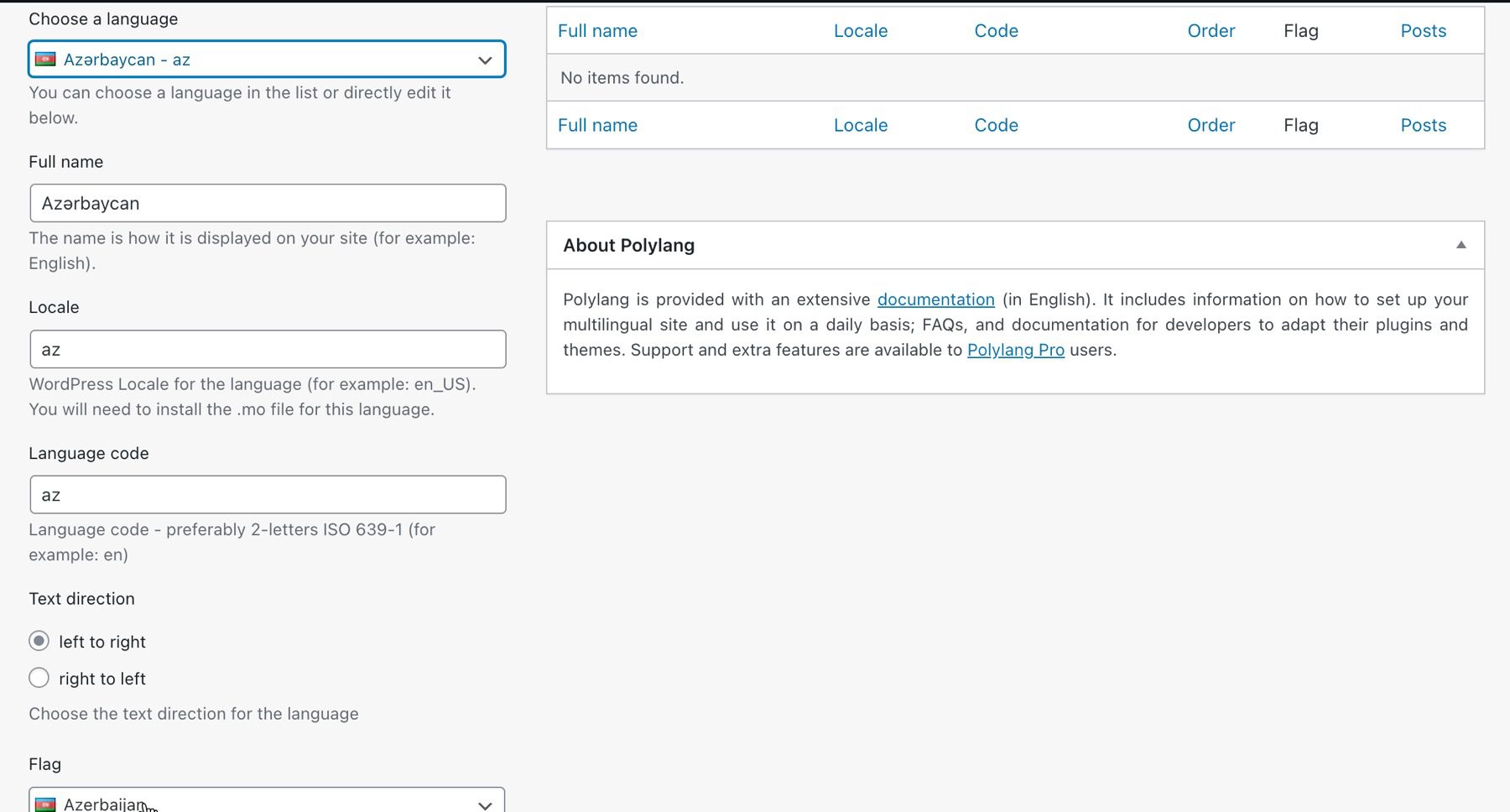
With over 500,000 active users and a 5-star review, Polylang is one of the best options available for translator plugins.
What We Liked About Polylang
- Multilingual Site Creation: Polylang allows you to create a multilingual site featuring from just one extra language to 10 or more, depending on your needs. There is no limit in the number of languages added and WordPress’ language packs are automatically downloaded when ready.
- Robust Core Features: Polylang and Polylang Pro share the same core, providing features such as translating posts, pages, media, categories, post tags, custom post types and taxonomies, and RSS feeds; RTL scripts are supported.
- Customizable Language Switcher: Polylang provides a customizable language switcher as a widget or a navigation menu item so users can easily switch language translations.
- Compatibility with Yoast SEO: Polylang is compatible with Yoast SEO, a popular WordPress plugin that helps optimize your website for search engines.
- Translation of Custom Tables: Polylang does not support the translation of custom tables, which can be a limitation for some users.
- Translation of Strings in Themes and Plugins: Polylang does not provide an easy way to translate strings in themes and plugins. This can challenge you if you want to translate your entire website.
Who Is Polylang Best For?
Polylang suits both beginners and advanced users who want a robust multilingual solution. It supports manual translations, language switchers, and custom post types.
Reviews on G2 say Polylang is great because it’s easy to use and works well with WordPress. It’s good for making bilingual or multilingual websites.
Polylang has a free plan, with costs arising from core translation features. Paid plans start at €99 per year (~$109) .
Get Polylang
8. Google Website Translator

Google Website Translator is fast, effective, simple, and easy. When you want a lightweight and efficient plugin, this one will do it. It translates your content, other plugins, and theme defaults, and you can set it all up with either a widget or a shortcode.
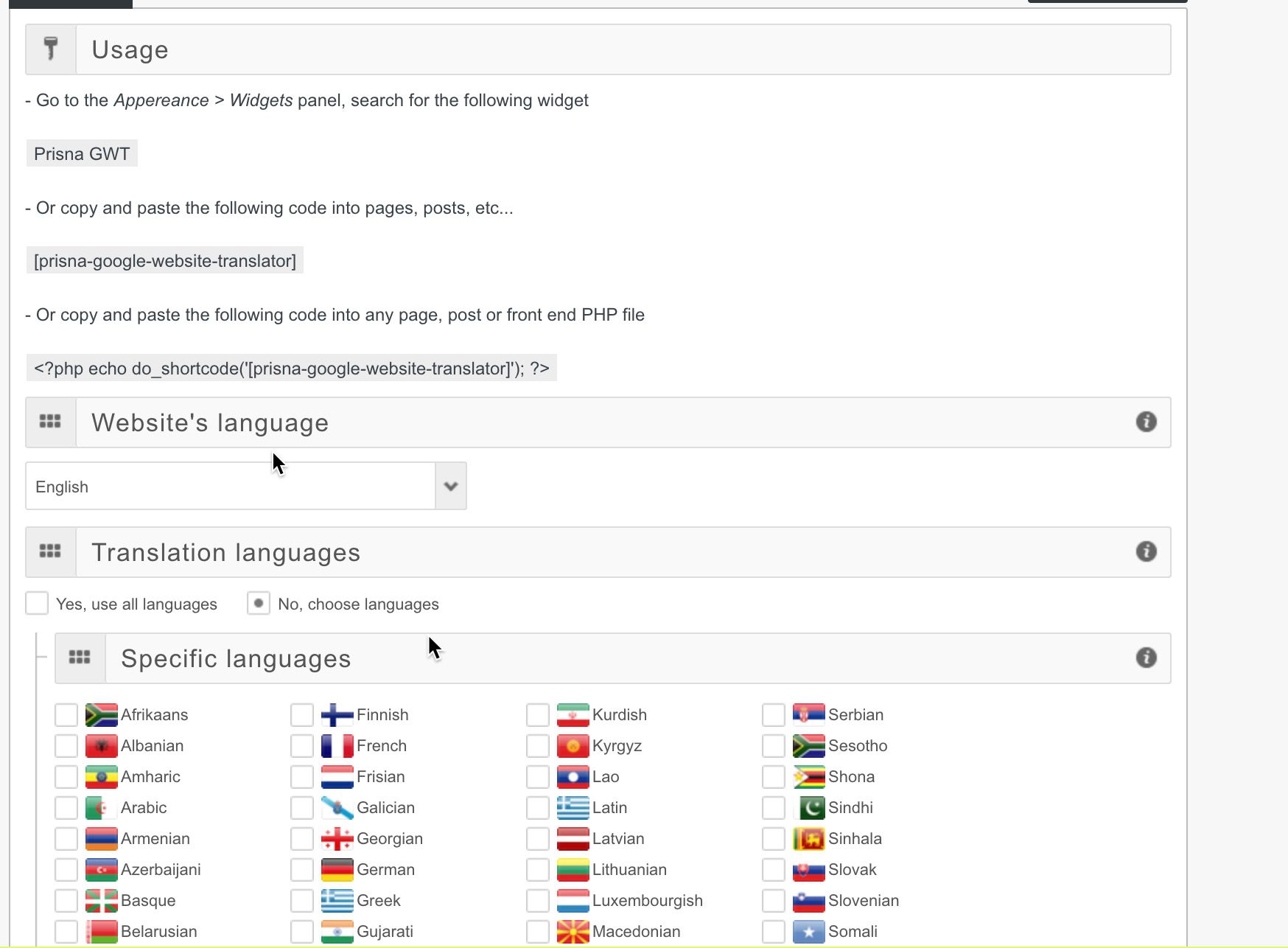
Any part of your site you must translate can be done using a shortcode. Without the need to bring in any files from other platforms, this plugin does the job automatically and leaves you to handle the other parts of the website administration.
What We Liked About Google Website Translator
- Easy setup: The plugin is easy to set up, with simple settings that are easy to understand. The settings include inline help that everybody can understand.
- Supports Automatic Site Translation with 100+ Languages: The plugin provides a simple and complete multilingual solution for WordPress. It brings the power of Google’s automatic translation service to translate your website into 100+ languages.
- Multiple styles: The plugin includes all the 3 inline and all 4 tabbed styles, giving users the flexibility to choose the style that best suits their website design.
- Widget and shortcode support: The plugin can be used as a widget or shortcode, making it easy to add a translation button and dropdown menu to any page or post on your website.
- Import/Export settings: The plugin allows you to import/export settings, making it easy to transfer configurations between websites or installations.
- Language Translation Consistency: While Google generates translations quickly, the quality varies significantly across different languages. For instance, translations for languages like Afrikaans, German, Portuguese, and Spanish tend to be more accurate, while others like Kurdish and Nepali are less reliable.
- Lack of Nuance: The automated translations may miss cultural nuances, idiomatic expressions, and context-specific meanings that a human translator would capture.
Who Is Google Website Translator Best For?
Google Website Translator is recommended for website owners who want to offer a quick translation option to visitors. It provides a dropdown menu for users to select their preferred language.
Google Website Translator is applauded on the WordPress repository for its integration ease and Google-powered translations. It provides a straightforward solution for multilingual WordPress websites.
Google Website Translator has a free plan, with costs arising from core translation features. Paid plans start at $50 per month .
Get Google Website Translator
9. Multisite Language Switcher

The Multisite Language Switcher is a plugin for WordPress that adds multilingual support to a WordPress multisite installation. It allows users to manage translations of posts, pages, custom post types, categories, tags, and custom taxonomies. The plugin uses flag icons from FamFamFam.
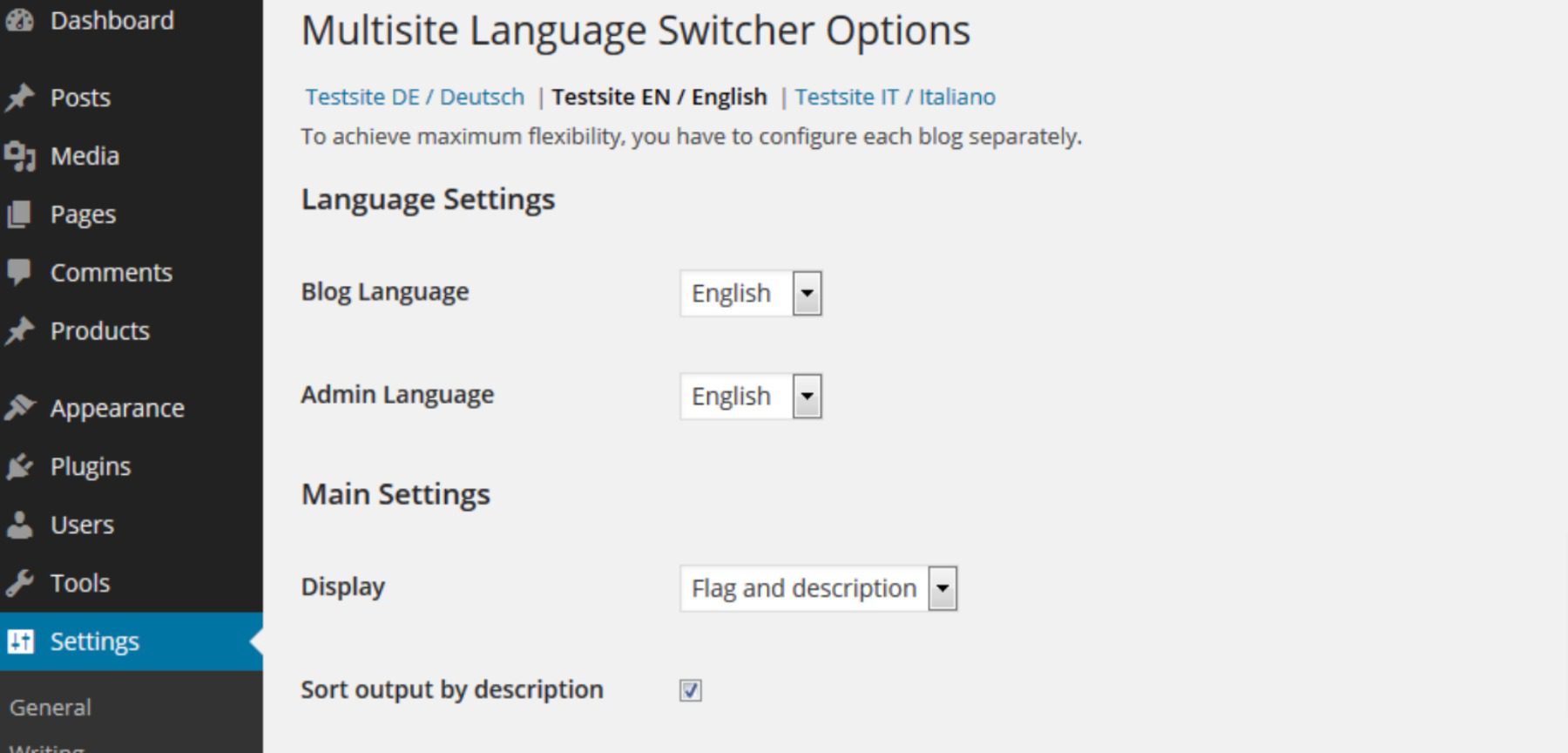
This plugin can incorporate one or multiple languages and is compatible with Yoast SEO and All-in-One SEO Pack. Free extensions allow you to set unique featured images for each language.
What We Liked About Multisite Language Switcher
- Multisite Localized Content: With WordPress Multisite, you can create separate websites for different languages. This means you can provide truly localized content tailored to cultural preferences in each language.
- Flexible Site Structure: Multisite allows you to choose how to structure your sites. You can use subdomains, subdirectories, or even different top-level domains (e.g., yoursite.ru, yoursite.de). Having distinct URLs for each site makes navigation faster for visitors.
- Complete Solution Out of the Box: Unlike other multilingual solutions, you don’t need an additional plugin to set up your multilingual site when using multisite.
- Supports translations of various content types: The plugin enables you to manage translations of posts, pages, custom post types, categories, tags, and taxonomies.
- More to Manage: Each language version is a separate website, which means you’ll need to manage them individually. This can be cumbersome if you have many languages.
- Complex Setup: Setting up multisite translation requires more technical knowledge than single-site translation.
- Testing Challenges: When testing new plugins or features, it’s harder for individual site administrators to work because they cannot activate/deactivate or install/delete plugins/themes directly. These actions can only be done through the Super Admin user.
Who Is Multisite Language Switcher Best For?
Multisite Language Switcher is suited to the developers managing WordPress multisite installations. This plugin is designed explicitly for multisite networks. It allows you to manage translations across multiple sites from a single dashboard.
Multisite Language Switcher stands out on the WordPress repository for its ability to manage translations across multiple WordPress sites. It garners appreciation for its functionality and effectiveness.
Multisite Language Switcher is free to use. Unlike the previous tools, it doesn’t have any paid plans.
Get Multisite Language Switcher
Comparing All The Best Translation Plugins
There is no lack of WordPress translation plugins that you can choose from. However, choosing the right plugin is a bit more difficult. Site owners should weigh their audience’s needs and demographics versus their site’s content. Some plugins work best with stores. Others work best with huge enterprise blogs with dozens of custom taxonomies and post types.
Translation Plugin Price Comparison
The options on our list offer free and premium plugins, so no matter the translation level you need, there’s an option for you. Take a look at the table below to review all of our translation plugins, as well as the pricing for each.
| Plugin | Price | Free Option | ||
|---|---|---|---|---|
| 🥇 | €39 per year (~$43) | ❌ | ||
| 🥈 | €89 per year (~$97.50) | ✔️ | ||
| 🥉 | €15 per month (~$16.50) or €150 per year | ✔️ | ||
| $39 per year | ✔️ | |||
| $9.99 per month ($99.90 per year) | ✔️ | |||
| $5.95 per month | ✔️ | |||
| €99 per year (~$109) | ✔️ | |||
| $50 per month | ✔️ | |||
| Free | ✔️ |
Top 3 Translation Plugins: Feature Comparison
Out of all of the translation plugins on our list, three offer the most bang for your buck. In the top spot, WPML is an excellent choice for those who need a premium solution. You can control what content you need to be translated or let WMPL do the work with automatic translations. If you want a preview of how your pages will look in other languages, try TranslatePress. It functions much like a front-end page builder but for translations. Finally, there’s Weglot . It works by taking all of your content, including that of other plugins, and automatically translates it, saving you time to focus on other tasks.
| 🥇 WPML | 🥈 TranslatePress | 🥉 Weglot | |
|---|---|---|---|
| Starting Price | €39 per year | $8.84 per month | $16.59 per month |
| Automatic Translation | ✔️ | ✔️ | ✔️ |
| Manual Translation | ✔️ | ✔️ | ❌ |
| Translation Memory | ✔️ | ✔️ | ❌ |
| SEO Optimization | ✔️ | ✔️ | ✔️ |
| Customize Languages | ✔️ | ✔️ | ✔️ |
| Multilingual Sitemaps | ✔️ | ✔️ | ✔️ |
| Visual Editor Integration | ✔️ | ✔️ | ✔️ |
| Compatibility with Popular Themes | ✔️ | ✔️ | ✔️ |
| Community Ratings | ⭐⭐⭐⭐ | ⭐⭐⭐⭐⭐ | ⭐⭐⭐⭐⭐ |
What Is The Best WordPress Translation Plugin?
Our top recommendation choice is WPML . As the most feature-rich option on our list, there are plenty of features for those looking for a good translation plugin. You can choose from manual or automatic translations, apply different languages depending on the page or post, and easily translate eCommerce products with WPML. Additionally, you can use your favorite page builder, Divi , Elementor , or similar, to make translations on the front end to view how they look in real-time. No matter what you need to translate, WPML is an excellent choice.
If you’re looking for the best WordPress plugins for various purposes, check out our ultimate list of recommendations !
Frequently Asked Questions (FAQs)
Before we wrap up, let’s answer some of your most common questions regarding the best WordPress translation plugins. Did we miss one? Leave a question below, and we will respond!
What is the best WordPress translation plugin?
What is the best free translation plugin for wordpress, what is the best google translate plugin for wordpress, how do you translate a wordpress website, which wordpress translation plugin is the easiest to use, how do i translate a wordpress site without a plugin, why are translations not working on my wordpress website, how can i implement multiple languages on my wordpress site, what is the best translation plugin for woocommerce stores, which company offers custom translation services for wordpress sites.
What do you think is most important when choosing WordPress translation plugins?
Article featured image illustration by igor kisselev / Shutterstock.com

Explore Our Top Picks
Here are our favorites! 👇
Get WPML Today!
With so many great options available, it can be hard to pick one. find out why wpml is our favorite. 👇.

By Deanna McLean
Deanna McLean is a blog author, and web developer. She studied graphic design at the University of Mississippi and loves all things, Hotty Toddy. (If you know, you know.) As an adventurous creative, there is nothing Deanna loves more than taking her son and two dogs on excursions in her Jeep.
Explore Divi, The Most Popular WordPress Theme In The World And The Ultimate Page Builder

Check Out These Related Posts

- Do You Need a WordPress Page Builder in 2024?
Posted on June 8, 2024 in WordPress
Page Builders gained prominence at a time when designing a website with WordPress entailed knowing HTML, CSS, and some PHP. Page builders gave users a true ‘no-code’ experience. If you’d allow us to say it, page builders like Divi were a bit of a reassurance for WordPress users....

- WordPress Pricing: How Much Does WordPress Cost? (2024)
Posted on June 6, 2024 in WordPress
WordPress is a powerful content management system (CMS) that makes creating a website accessible to everyone. It’s easy to use, highly customizable, and capable of building any website you can dream of. But with all the talk of its ease of use, a lingering question pops up: how much does...

- How to Get Started with WordPress (2024 Guide)
Posted on June 4, 2024 in WordPress
Are you looking to create your own website but feel overwhelmed by the technical jargon? You’re not alone. Setting up a website can seem scary, but with the right tools and guidance, it’s much easier than you think. Thanks to a powerful content management system (CMS) called WordPress,...
WPML in combination with Divi is an absolute horror. There is no beginning and end to the documentation, you get to read 10 different posts or articles just to get to the same point, lots of words from WPML but hardly any help. I love Divi to death, but WPML certainly does not: the whole page, sometimes consisting of 30 odd parts, is cut to pieces for translation, making it a mess when manually correcting translations… which is a must, since importing xliff files is flawed, where nobody can explain why some pages or posts are exported and some are not. Complete and utter mess, just finished my absolute last job using WPML. Beware!
Did you try Falang for Divi available on the elegantheme marketplace Work with Falang for WordPress plugin.
You can translate the content in each module directly
We use Linguise, that is a cloud translation system, and you can manually make translation revisions from frontend. It’s mostly like Weglot but way cheaper and nicely integrated with all DIVI content
We have recently designed a Divi website with G Translate, and we have used some others too like WPML but this list is so beneficial for us. Thankyou for sharing these resources.
My choice from this list is Polylang. It works nicely with Divi as well.
For me the most important criteria was the SEO component. I started using TranslatePress which is amazing and simple to use. I moved to WPML because I wanted separate subdomains for every language and the ability to use a social sharing automation based on categories in different languages.
Leave A Reply Cancel reply
- Recent Posts
- Download a Free Spa Theme Builder Pack for Divi
- Wix vs Divi AI: Which AI Website Builder to Choose in 2024?
- Divi Resources
- Theme Releases
- Tips & Tricks
974,872 Customers Are Already Building Amazing Websites With Divi. Join The Most Empowered WordPress Community On The Web
We offer a 30 Day Money Back Guarantee, so joining is Risk-Free!
Divi Features
- All Features Explore Divi
- Divi Modules
- Divi Layouts
- No-Code Builder
- Ecommerce Websites
- Theme Builder
- Marketing Platform
- Speed & Performance
- Premium Support
- Divi Marketplace
- Divi AI Brand New!
- Divi Hosting
- Extra Theme
- Bloom Plugin
- Monarch Plugin
- Plans & Pricing Get Divi Today
- Documentation
- Help Articles & FAQ
- 24/7 Support
- Developer Docs
- System Status
- Product Updates
- Best Plugins
- Best Hosting
- Divi Meetups
- Divi Facebook Group
- Divi Examples
- Divi Integrations
- Divi Reviews
- Community Forum
- Affiliate Program
- Terms of Service
- Privacy Policy
Copyright © 2024 Elegant Themes ®

IMAGES
VIDEO
COMMENTS
Question 7. What is a cross-sectional design? a) A comparison of two or more variables longitudinally. b) A design that is devised when the researcher is in a bad mood. c) The collection of data from more than one case at one moment in time. d) Research into one particular section of society, e.g. the middle classes.
Below given are top 20 important Research Design MCQ with answers. These updated multiple choice questions on research design are helpful for BBA, B Com, MBA, MMS, BMS, B Sc, Engineering, PGDM, M Phil and Ph D students and researchers. These MCQs will help for UGC NET, SET, MPSC, UPSC and other competitive entrance exams.
A. Research design B. Research proposal C. Research hypothesis D. Research report ... A. Multiple choice questions B. Dichotomous questions C. Open ended questions D. Structured questions ... D. Selecting a research agency Answer Key of Unit II 1 B 11 D 2 B 12 C 3 B 13 A 4 D 14 B . 5 B 15 C 6 D 7 B 8 B ...
Latest Research Design MCQ Objective Questions. Research Design Question 1: A research design in which either the investigator or the participant is not aware of the treatment a participant is receiving, refers to: Single Blind Study. Half Blind Study. Double Blind Study. Longitudinal Study. Answer (Detailed Solution Below) Option 1 : Single ...
Multiple Choice Questions. Research: A Way of Thinking. The Research Process: A Quick Glance. Reviewing the Literature. Formulating a Research Problem. Identifying Variables. Constructing Hypotheses. The Research Design. Selecting a Study Design.
Key Features · The entire research process is covered from start to finish: Divided into nine parts, the book guides readers from the initial asking of questions, through the analysis and interpretation of data, to the final report · Each question and answer provides a stand-alone explanation: Readers gain enough information on a particular topic to move on to the next question, and topics ...
Multiple Choice Quizzes. Try these quizzes to test your understanding. 1. There exist two types of research designs only. True. False. 2. Which of the following are research design options? quantitative, qualitative, critical studies or a mixture of each of these.
Multiple Choice Quizzes. Try these quizzes to test your understanding. 1. Research analysis is the last critical step in the research process. True. False. 2. The final research report where a discussion of findings and limitations is presented is the easiest part for a researcher. True.
A. Participants are f ree to question and correct the researcher's assumptions B. Researchers can control for extraneous variables by using standardised questionnaires C. Researchers can obtain feedback on their study's findings from participants D. The practice of reflexivity ensures that the researcher continuously reviews their role in ...
Basics of Research Design MCQs. These Basics of Research Design multiple-choice questions and their answers will help you strengthen your grip on the subject of Basics of Research Design. You can prepare for an upcoming exam or job interview with these 50 Basics of Research Design MCQs. So scroll down and start answering.
A research design is a strategy for answering your research question using empirical data. Creating a research design means making decisions about: Your overall research objectives and approach. Whether you'll rely on primary research or secondary research. Your sampling methods or criteria for selecting subjects. Your data collection methods.
Put your skills to the test with our engaging MCQs and excel in the science of efficient experimentation. This MCQ on Experimental Design will help you to understand the basic principles and applications of designs of experiments in biological research. You may also like: Experimental Designs Notes | Types of Experimental Designs - Notes.
5. Interval data can be ordered, but ordinal data cannot., In an experimental design, the dependent variable is 1. The one that is not manipulated and in which any changes are observed. 2. The one that is manipulated in order to observe any effects on the other. 3. A measure of the extent to which personal values affect research. 4.
research design multiple choice questions with answers. Questions. Download PDF. 61 Before submitting your dissertation, you should ensure that: A Your writing is free of sexist, racist and disablist language. B Other people have read your final draft. C You have proofread it thoroughly. D All of the above. View Answer.
1. The document provides 54 multiple choice questions related to research methodology. The questions cover topics such as research design, data collection methods, variables, hypotheses, literature reviews and more. 2. Multiple choice questions are used to test knowledge of key concepts in research methodology including the different types of research, roles of hypotheses, characteristics of ...
This document provides a multiple choice quiz with answers on research methods. It covers topics like the definition of research, qualities of researchers, research design, sampling methods, quantitative vs qualitative research, variables, and experimental vs non-experimental research. The quiz contains 39 multiple choice questions testing knowledge of key research terminology and concepts.
Multiple Choice Quiz. Take the quiz to test your understanding of the key concepts covered in the chapter. Try testing yourself before you read the chapter to see where your strengths and weaknesses are, then test yourself again once you've read the chapter to see how well you've understood. Tip: Click on each link to expand and view the ...
The quiz aimed to sharpen your critical thinking skills and reinforce our grasp on essential concepts in the realm of research. By actively participating in this exercise, we deepened your appreciation for the significance of selecting the right research methods to achieve reliable and meaningful results. 1.
A research design is a blueprint for the collection, measurement, and analysis of data, based on _____ of the study. the purpose. the research questions. the introduction. 2. Multiple Choice. 30 seconds. 1 pt. An exploratory study is undertaken when not much is known about _____ at hand, or no information is available on how similar problems ...
Quantitative research design is defined as a research method used in various disciplines, including social sciences, psychology, economics, and market research. It aims to collect and analyze numerical data to answer research questions and test hypotheses. Quantitative research design offers several advantages, including the ability to ...
If you are going to use multiple-choice questions, you must design and communicate them clearly and concisely. Poorly written MCQs cause problems. Many (60%+, according to multiple research sources) MCQs have flaws. Flawed MCQs can compromise assessment data, confuse participants, and cause morale, bias, legal, and other problems for people and ...
a) Research refers to a series of systematic activity or activities undertaken to find out the solution to a problem. b) It is a systematic, logical and unbiased process wherein verification of hypotheses, data analysis, interpretation and formation of principles can be done. d) It enhances knowledge.
Revise your knowledge with these multiple choice quiz questions. Chapter 2: Research in Psychology: Objectives and Ideals. Chapter 3: Research Methods. Chapter 4: Experimental Design. Chapter 5: Survey Design. Chapter 6: Descriptive Statistics. Chapter 7: Some Principles of Statistical Inference. Chapter 8: Examining Differences between Means ...
AP Research. AP Seminar. Arts. About the AP Art and Design Program. AP 2-D Art and Design. AP 3-D Art and Design. AP Drawing. AP Art History. AP Music Theory. English. AP English Language and Composition. AP English Literature and Composition. History and Social Sciences. AP African American Studies.
A health care disparity typically refers to differences between groups in health insurance coverage, affordability, access to and use of care, and quality of care. The terms "health inequality ...
To enhance your experience on our site, SAGE stores cookies on your computer. By continuing you consent to receive cookies. Learn more. Close
Google Website Translator has a free plan, with costs arising from core translation features. Paid plans start at $50 per month. Get Google Website Translator. 9. Multisite Language Switcher. The Multisite Language Switcher is a plugin for WordPress that adds multilingual support to a WordPress multisite installation.